Photos: What Atomic Bombs Did to Hiroshima and Nagasaki

© United States Army


© United States Army
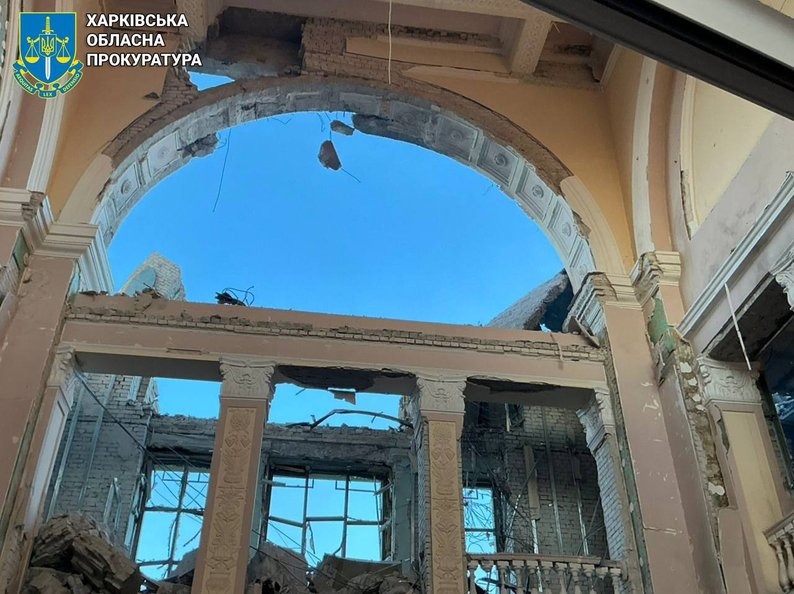

Russia’s Lozova drone strike killed a railway worker and injured civilians, including two teenagers, during Russia’s heaviest drone and missile attack on the city since the start of the full-scale war. According to the Ukrainian Air Force and local officials, the assault overnight on 5 August 2025 involved 46 Shahed-type and decoy UAVs, and a ballistic Iskander-M missile.
The Ukrainian Air Force reported that from 19:00 on 4 August, Russia launched an air attack from the directions of Kursk, Bryansk, Oryol, and Primorsko-Akhtarsk in Russia, using Shahed drones, UAV decoys of various types, and an Iskander-M missile from Bryansk Oblast.
Ukraine’s air defenses, including aviation, anti-aircraft missile units, electronic warfare, and mobile fire groups, intercepted or suppressed 29 drones by 08:00.
“Hits from 17 drones were recorded in the eastern direction, as well as one ballistic missile, and debris from downed drones fell in three locations in the southern and northeastern directions,” the Air Force wrote.
In Lozova, Kharkiv Oblast, a massive drone strike killed one person and injured others, local authorities reported. The mayor of Lozova, Serhii Zelenskyy, said that critical infrastructure, high-rise buildings, detached houses, and an educational institution were damaged. He noted that emergency services, medics, and rescue workers were operating on site and that restoration of water supply was underway.
Zelenskyy added that parts of the city remained without power, including Avylivka and the Katerynivskyi district. Public transport routes were also affected.
Images released by the Kharkiv Oblast Prosecutor’s Office show damage at the Lozova railway station, including a collapsed roof. The station was temporarily closed, and changes were introduced to suburban train services, the city council and Ukrzaliznytsia reported.
Trains Nos. 66/65 and 166/165 on the Uman–Cherkasy–Kharkiv route were redirected via an alternate path. Passengers to and from Lozova were being transported by bus to the Paniutyne station. Ukrzaliznytsia warned of delays of up to one hour due to use of a reserve locomotive.
According to the State Emergency Service, six fires broke out in Lozova as a result of the drone strike. Destruction of other buildings was also recorded.
The Kharkiv Oblast Prosecutor’s Office clarified that Russia has used over 30 Shahed-type attack drones — for some reason, the Kharkiv local authorities and prosecutor’s office always refer to them as “Geran-2” by their Russian designation.
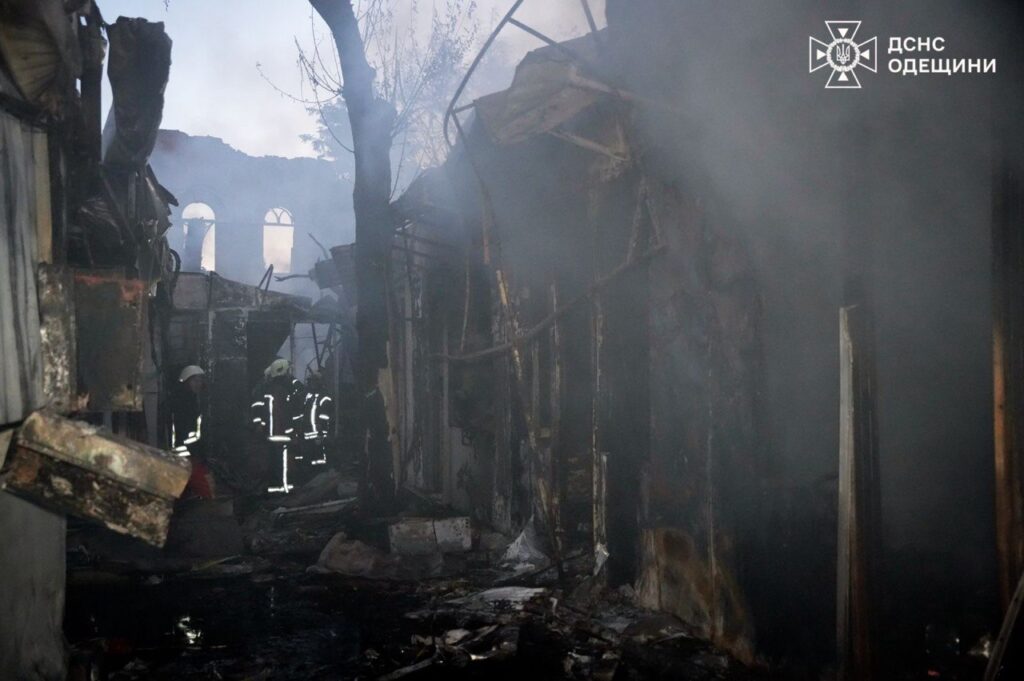

Russian forces launched a night assault on Ukraine using missiles, drones and guided aerial bombs, according to Air Force data.
Three people were injured in Russian shelling of Dnipropetrovsk Oblast, including a 4-month-old infant who remains in critical condition, Dnipro Oblast Governor Serhii Lysak said.
Nikopol, Marhanets, Myrivska, Pokrovska communities were under Russian fire.
According to Lysak, Russian forces shelled the Nikopol area with artillery, attacked with FPV drones and dropped ammunition from UAVs. A transport company in Marhanets was damaged during the assault.
The attacks extended beyond Dnipropetrovsk Oblast. In Kherson Oblast, one person died in Russian artillery fire on Antonivka village.
“From early morning, Russians cut short the life of a Kherson Oblast resident, for a man born in 1979,” Kherson Oblast Governor Oleksandr Prokudin said.
In Odesa, a strike on a radio market sparked fires that destroyed dozens of trading pavilions containing electronics and household appliances, the State Emergency Service reported. A separate fire erupted at an abandoned dormitory.
The Russian military regularly attacks Ukrainian oblasts with various types of weapons, killing civilians and destroying hospitals, schools, kindergartens, energy and water supply facilities.
The Ukrainian authorities and international organisations qualify these strikes as war crimes by the Russian Federation and emphasise that they are of a targeted nature.
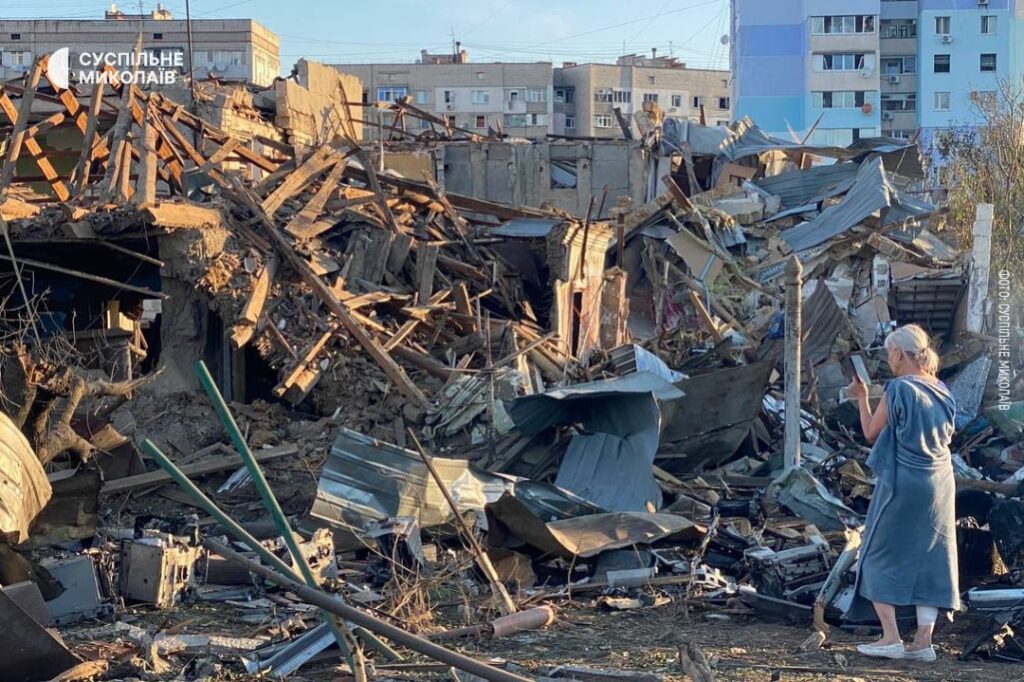

Nightly Russian drone attacks again battered Ukraine as missiles and Shaheds rained down on several cities, causing injuries and damage. Local authorities said explosions and fires struck homes and infrastructure across the country as power outages and destruction mounted.
In the late evening of 2 August, Russian forces launched missiles on Mykolaiv and Kherson. The State Emergency Service reported that in Mykolaiv explosions destroyed single-family homes and damaged apartments, igniting fires in a residential district.
The head of Mykolaiv Oblast, Vitalii Kim, said seven people were injured, with four treated on site and three hospitalized. A 57‑year‑old man and a 74‑year‑old man were hospitalized in moderate condition, and a 32‑year‑old man received outpatient care. Kim confirmed that three houses were destroyed, 23 more were damaged, and 12 apartment buildings, six vehicles, a postal branch and a building materials store were also hit. After the attack, parts of Mykolaiv Oblast lost electricity. The head of Kherson Oblast, Oleksandr Prokudin, also reported power outages after evening missile explosions.
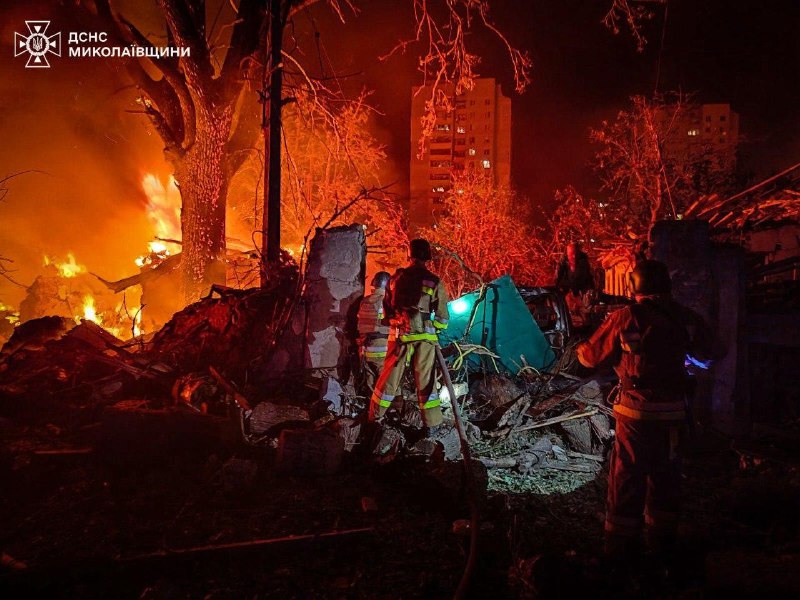
Russian forces struck Kharkiv in the night with two Shahed drones. Oleg Synehubov, the head of Kharkiv Oblast, reported that a central district of the city was hit. Mayor Ihor Terekhov said one explosion damaged warehouse buildings near residential areas, with no injuries there. Another drone fell in a forest without detonating.
Synehubov said that explosions in Chuhuiv and Balakliia caused fires in detached homes. In Chuhuiv, Mayor Halyna Minaieva said three women suffered acute stress reactions, and houses had windows and roofs damaged. In Balakliia, city military administrator Vitalii Karabanov said more than ten drones struck one street, setting over ten homes on fire. He confirmed at least one injured person. Casualty numbers there are still being clarified.
In Kyiv, city military administration chief Tymur Tkachenko confirmed a missile strike during the night, with details still unknown.
Lithuanian volunteer organization Blue/Yellow says that Russia’s previous attack on 31 July destroyed its Kyiv warehouse. Lithuanian broadcaster LRT reported that a Shahed drone completely demolished the building used for storing humanitarian aid before shipment to the front. The organization said the warehouse contained mainly helmets and protective vests and that surrounding buildings were also damaged.
The Air Force of Ukraine reported that between 19:00 on 2 August and early 3 August, Russia attacked with 76 Shahed and decoy drones, and seven missiles, including an Iskander‑M ballistic missile, five S‑300/S‑400 surface‑to‑air missiles used for ground attacks, and one Kh‑22 cruise missile.
Ukrainian air defenses shot down or suppressed 61 air targets: 60 drones and one ballistic missile. Despite this, six missiles and 16 drones struck eight locations, with debris falling in two more places. Air defense units, aviation, radio‑electronic warfare systems and mobile fire teams all took part in repelling the assault.
On the morning of 3 August, Russian forces used artillery against Kostiantynivka in Donetsk Oblast. City military administrator Serhii Horbunov reported that shells hit residential areas, killing one person. He said that Russian troops struck civilian infrastructure and confirmed that the attack resulted in at least one death.


The Russian military has been throwing troops at the Toretsk direction for over six months, but each time they are crushed by Ukrainian defenses. Russians have lost about 50,000 soldiers on this front, with more than 20,000 irreversible casualties, Army TV reports.
“50,000 people — that’s a good-sized European stadium filled to the brim. But the Kremlin regime didn’t bring these people for football. It brought them to die near Toretsk,” Major Serhii Khominsky, Ukrainian press officer of the 100th Separate Mechanized Brigade, says.
Khominsky stresses that the 100th Brigade has held this crucial front line for over a year. Despite repeated Russian attempts to break through from Horlivka toward Kostyantynivka, they have only reached the outskirts of Toretsk and failed to advance further.
“This is one of the front sectors where the enemy has made the least progress. It frustrates them, but they can’t change anything — thanks to the heroism of our fighters,” he emphasizes.
Ukrainian defenders have faced nearly every form of Russian tactics here: from massive armored assaults to nighttime infantry storm attacks.
“You could say the only things we haven’t seen are battle kangaroos and penguins. Everything else has been tried,” Khominsky adds with bitter irony.
The officer also reveals that Russia has started using ground robotic combat systems. However, these machines proved nearly powerless in the devastated urban environment.
“High-rise buildings turned into thousands of tons of rubble. These ruins are hard to pass even for a human, let alone a robotic system,” Khominsky explains.

Thanks to your incredible support, we’ve raised 70% of our funding goal to launch a platform connecting Ukraine’s defense tech with the world – David vs. Goliath defense blog. It will support Ukrainian engineers who are creating innovative battlefield solutions and we are inviting you to join us on the journey.
Our platform will showcase the Ukrainian defense tech underdogs who are Ukraine’s hope to win in the war against Russia, giving them the much-needed visibility to connect them with crucial expertise, funding, and international support.
We’re one final push away from making this platform a reality.


© Sergey Ponomarev for The New York Times


US President Donald Trump has stunned with details on the death toll in Ukraine. The American leader claims that since the start of 2025, Russia has lost over 112,500 soldiers, while Ukraine has suffered around 8,000 military casualties, not including the missing.
“I have just been informed that almost 20,000 Russian soldiers died this month in the ridiculous War with Ukraine. Russia has lost 112,500 soldiers since the beginning of the year,” Trump wrote on Truth Social on 1 August.
He called it “a lot of unnecessary death” and noted that Russia continues to strike Kyiv and other Ukrainian cities, killing civilians.
“This is a War that should have never happened — This is Biden’s War, not ‘TRUMP’s.’ I’m just here to see if I can stop it!” he added.
Earlier today, Russian ruler Vladimir Putin cynically commented on the war in Ukraine for the first time since US President Donald Trump issued his 10-day ultimatum on Russia.
Putin confirmed that Russia’s conditions for ending the war, announced back in summer 2024, remain unchanged.
Last year, he insisted on the withdrawal of Ukrainian troops from the occupied territories of Donetsk, Luhansk, Kherson, and Zaporizhzhia. Moscow has illegally incorporated these Ukrainian regions into its Constitution. Additionally, Russia demands that Ukraine renounce NATO membership, enshrine a non-nuclear status, and lift sanctions.


Kharkiv stands in ruins after Russia attacks. Daily strikes have devasted the city and caused over €10 billion in damage to Kharkiv, Mayor Ihor Terekhov told Report.
Russian assualts on Ukrainian civilians have intensified amid US President Donald Trump’s attempts to settle peace through diplomatic means, leading to a rising number of civilian casualties.
According to the city’s head, Russia has been systematically targeting Kharkiv’s civilian infrastructure for over three years. More than 12,000 sites have been destroyed or damaged, and most of them are residential buildings.
“160,000 Kharkiv residents have lost their homes. Explosions every day, destruction every day, and sadly, deaths and injuries,” says Terekhov.
The mayor notes that over 9,500 of the destroyed sites are residential buildings, meaning Russian missiles and drones are primarily targeting civilians. Since February 2022, Kharkiv has not seen a single day without shelling.
“Currently, the need for windows exceeds 50,000. Every strike increases this number by another thousand, one and a half, two. The record was more than five thousand in one attack,” the mayor revealed in June.
“We are facing massive destruction. The city will need even more funds to rebuild,” Terekhov states, estimating the damage at around €10 billion.
Still, he stressed, “no amount of money can bring back the lives and health lost.”
Terekhov underscored that Kharkiv is under constant attack and that “civilian targets are primarily being hit.”
The scale of destruction and number of victims make it clear: Russia is deliberately devastating Ukraine’s largest city near the border.
Earlier, Russia tested its new modified bomb in an attack on Kharkiv. Children, an infant, and a pregnant woman were among the wounded. A new type of aerial bomb, the UMPB-5, with 250-kg warhead, hit the central part of the city in the first known use of this weapon.
Two airstrikes were launched from over 100 kilometers away. The strikes damaged 20 residential buildings, including 17 apartment blocks in the Shevchenkivskyi and Kholodnohirskyi districts. The blast wave shattered over 600 windows, forming a crater in the street. Seven cars were destroyed by fire, and 18 more were damaged. One industrial facility caught fire, resulting in a large-scale blaze.


© Oksana Parafeniuk for The New York Times
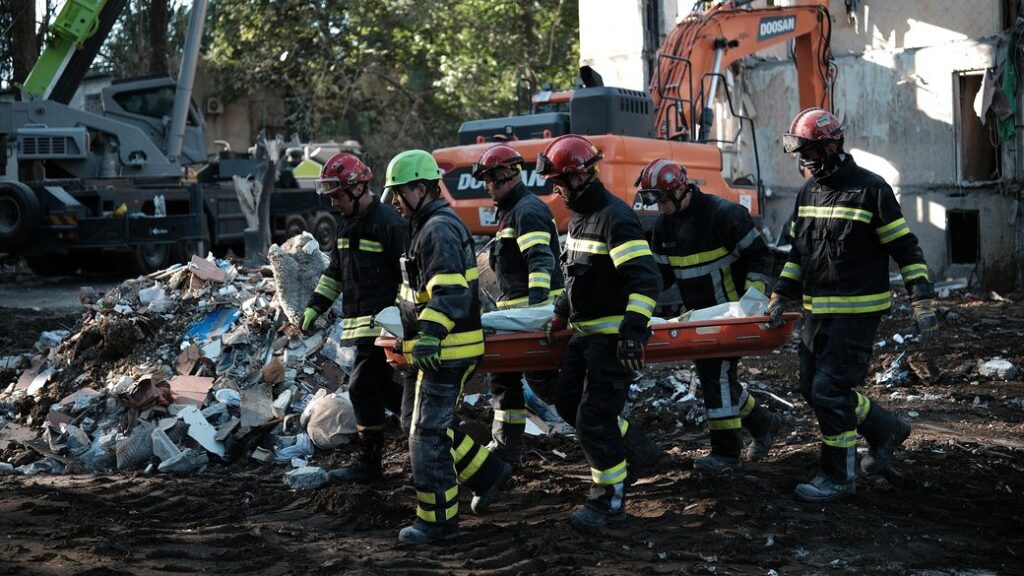

The death toll from Russia’s attack on 31 July in Kyiv has reached 31 this morning, and the city is mourning as rescuers continue their work. A 2‑year‑old and a six-year-old among the victims. The number may rise as emergency workers dig through the rubble.
The combined missile and drone attack on Kyiv overnight on 31 July caused the destruction of an entire section of a residential high‑rise in Sviatoshynskyi district. Crews of the State Emergency Service of Ukraine have worked through the night under spotlights, dismantling 70% of the collapsed structure and recovering bodies from the ruins. The agency confirmed that thousands of tons of rubble have already been removed, but several residents remain missing.
As of 10:39 of 1 August, head of Kyiv City Military Administration Tymur Tkachenko said on Telegram that rescuers had recovered more bodies and that the death toll had risen to 31, including three children. His earlier morning updates showed the toll steadily increasing during the ongoing search.
According to the Emergency Service, the Russian attack also wounded 159 people, including 16 children.
Earlier updates from local authorities reported that apart from Sviatoshynskyi district, buildings in Solomianskyi, Shevchenkivskyi, and Holosiivskyi districts were also damaged. Windows were shattered, roofs destroyed, and basic services disrupted in several areas.
The attack also damaged railway infrastructure in one part of Kyiv, the Kyiv Islamic Cultural Center near a central mosque, and the premises of the Dovzhenko National Film Studio.
Kyiv mayor Vitalii Klitschko announced yesterday that 1 August was declared a day of mourning in the city. Flags were lowered on municipal buildings, and all entertainment events were canceled. Both state and private institutions were asked to lower their flags as well.

Suspilne interviewed long‑time resident Raisa Adamenko, who explained that she was away from home when the strike happened. Her two children managed to escape through smoke moments before the missile destroyed the building. She lost her home and said she knew many of the neighbors who died, including a couple who returned home from a bomb shelter between alarms and were killed.
“From the ninth floor, Andrii and Natasha were in the bomb shelter. When they came back from it, the alarm was announced again. They had a smoke and went home. Then the missile came and they were killed,” Raisa said.

State Emergency Service spokesperson Pavlo Petrov told Suspilne that search operations are ongoing because people remain missing. Once specialists confirm there are no more victims under the rubble, work will move to clearing dangerous fragments so that the site can be made safe.
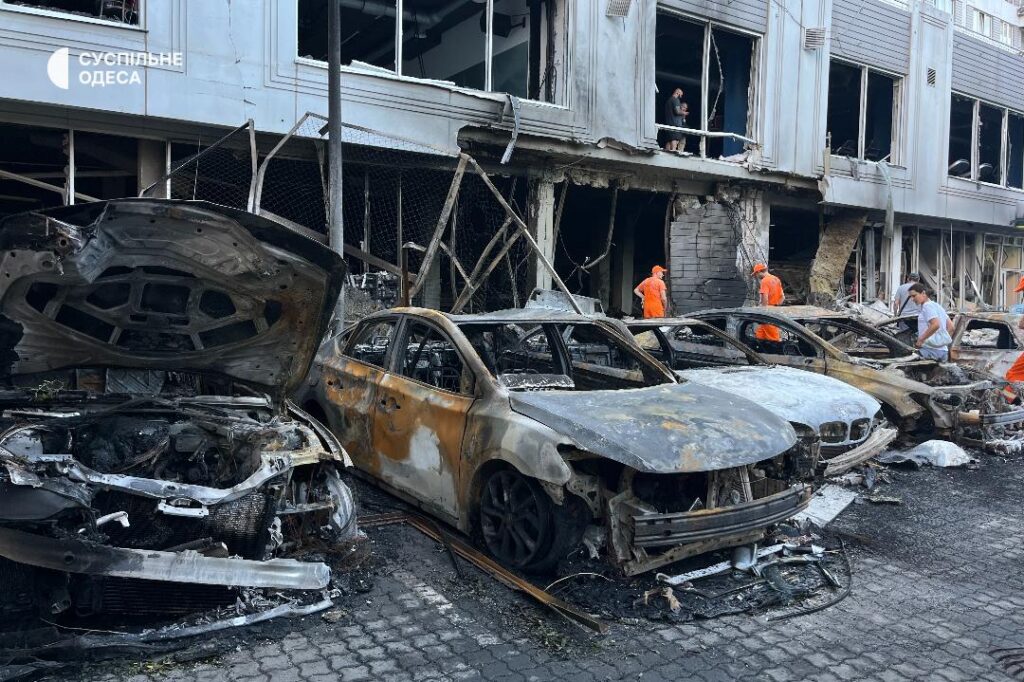

Russia fired 6,297 Shahed-type kamikaze drones and Gerbera-type decoy targets at Ukraine in July 2025, marking an absolute monthly record since the beginning of the full-scale invasion, according to OSINT analyst Kyle Glen who analyzed official Ukrainian Air Force report.
The July figure represents a 1,378% increase compared to July 2024, when 426 drones were launched. The scale of July attacks equals the total number of drones launched over ten months of 2024 — from January through October inclusive.
July is also the first month to see more than 6,000 drones reported by the Ukrainian Air Force, this follows June when more than 5,000 were reported for the first time, according to Glen.
“July also had periods of relative calm when Russia held off on major launches (likely due to poor weather),” he added.
The data revealed a steady monthly escalation in drone attacks. The analyst attributes this trend to Russia’s expansion of drone production facilities in the second half of 2024 and early 2025. Ukrainian air defense forces now operate under unprecedented attack volumes that constantly increase in complexity due to evolving enemy tactics.
The Institute for the Study of War (ISW) reported that Russian forces have installed thermal imaging cameras on some Shahed drones to improve strike accuracy.
Previous reports said that Russia prepares thousands of strikes daily.
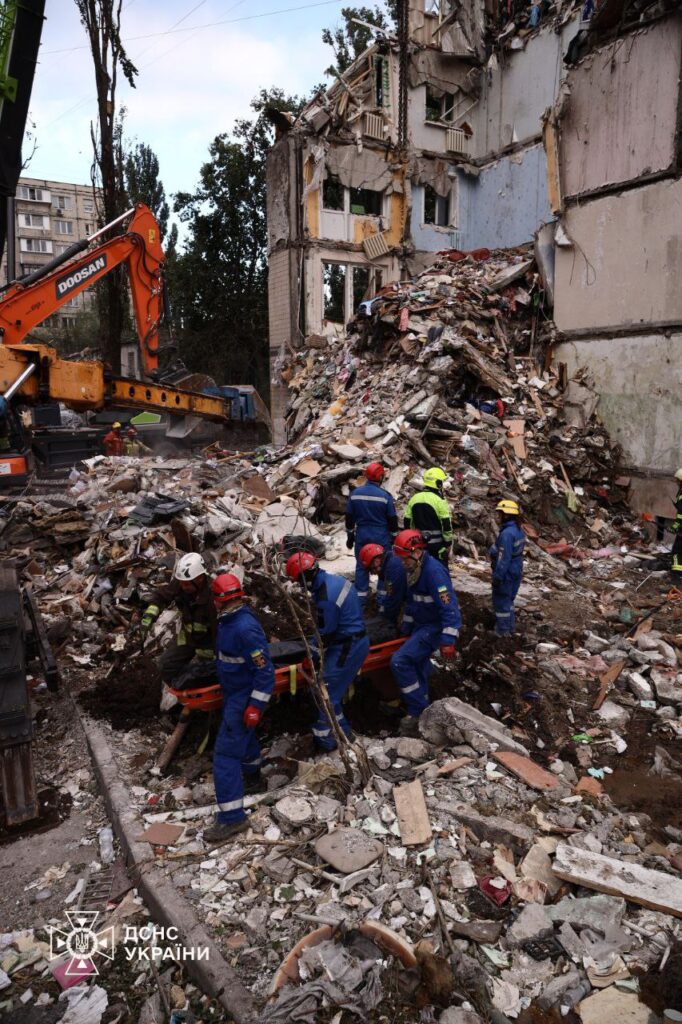

Lithuania’s Foreign Ministry summoned Russia’s temporary chargé d’affaires on 31 July, following massive strikes on Ukrainian cities including Kyiv, according to a statement from the Lithuanian Ministry of Foreign Affairs.
The Russian representative received a protest note regarding strikes on Kyiv, Zaporizhzhia, Dnipro, Sumy, Kharkiv, Kherson and other Ukrainian oblasts that killed dozens and wounded hundreds of civilians, the ministry reported.
The statement follows a Russian missiles and drones attack that ripped through Kyiv overnight on 31 July, collapsing apartment buildings and setting fires in several districts of the city. The attack killed at least 15 civilians and injured over 130 people. Russian missile struck an apartment building kin one of the Kyiv’s disctrict, collapsing its entire section.
The Lithinuan FM wrote in the statement after the morning attack that “Russia’s military actions against Ukraine’s civilian population and systematic cruel treatment of prisoners of war are unacceptable and illegal.
Lithuania pledged to continue efforts to ensure those responsible for these and other war crimes face criminal prosecution.
Lithuanian Foreign Minister Kęstutis Budrys called for “increased pressure” on Russia and its partners following the deadly strike on the Ukrainian capital.
The Russian attack was also condemned by Finland’s Foreign Minister Elina Valtonen, whose country currently chairs the OSCE, and her Estonian counterpart Margus Tsahkna.
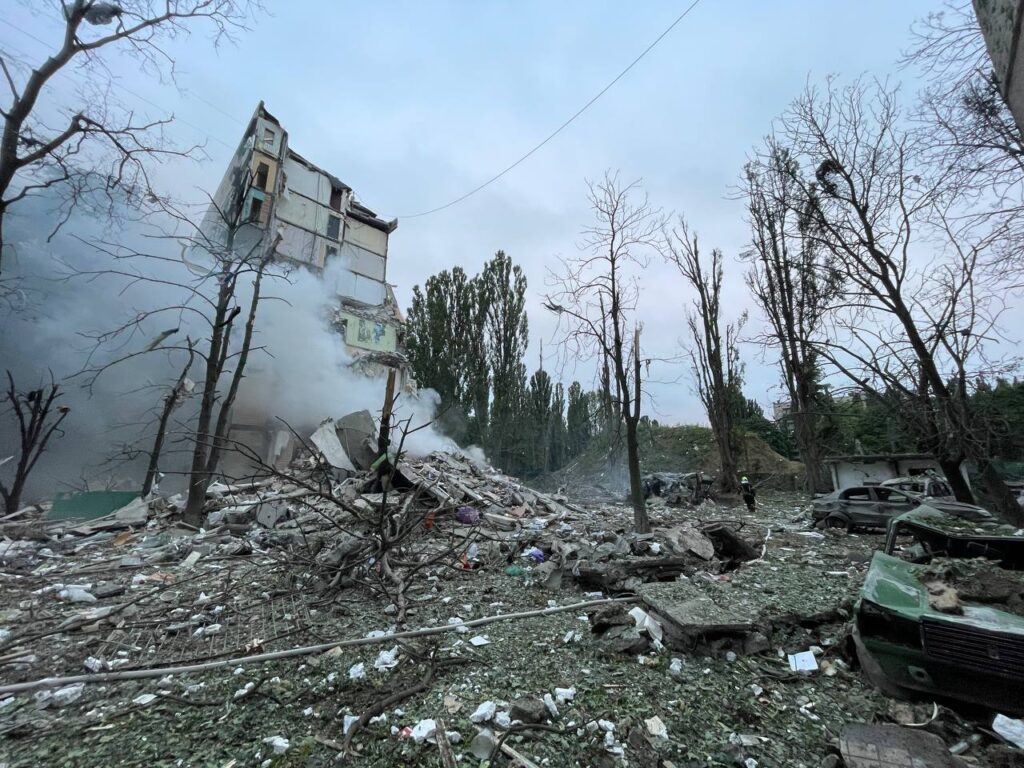

Russian missiles and drones ripped through Kyiv overnight on 31 July, collapsing apartment buildings and setting fires in several districts of the city. The attack killed at least six civilians and injured 52. The strikes caused destruction in Sviatoshynskyi, Solomianskyi, Holosiivskyi and Shevchenkivskyi districts and were described by city officials as one of the heaviest attacks on the capital in weeks. Ukraine shot down most of 300 explosive drones, but five of eight ballistic missiles reached the city, hitting apartment buildings.
Kyiv mayor Vitalii Klitschko reported that the strikes destroyed homes and killed six civilians. Russians killed four people in Kyiv’s Sviatoshynskyi district when a Russian missile struck an apartment building, collapsing its entire section. Klitschko called the damage in Sviatoshynskyi horrific. Two more people died in Solomianskyi district where a missile hit another residential building.
In the morning, Ukraine’s President Volodymyr Zelenskyy shared a video showing the ruined section of a high-rise in Sviatoshynskyi district, captioned:
“Kyiv. Rocket strike. Direct hit on a residential building. People under the rubble. All services are on site. Russians are terrorists.”
Head of the Kyiv Military Administration Tymur Tkachenko said 52 civilians needed medical help after the strikes, and medics hospitalized 30 of them. Two civilians were rescued alive from under the rubble.
Interior minister Ihor Klymenko reported that one of the rescued was a man, blocked under the rubble of a collapsed apartment section. He fell from the second floor to the first and got trapped by debris, so emergency workers broke a hole through a neighboring wall and used a tunnel to reach him safely. The emergency workers kept voice contact with him for three hours during the entire operation.
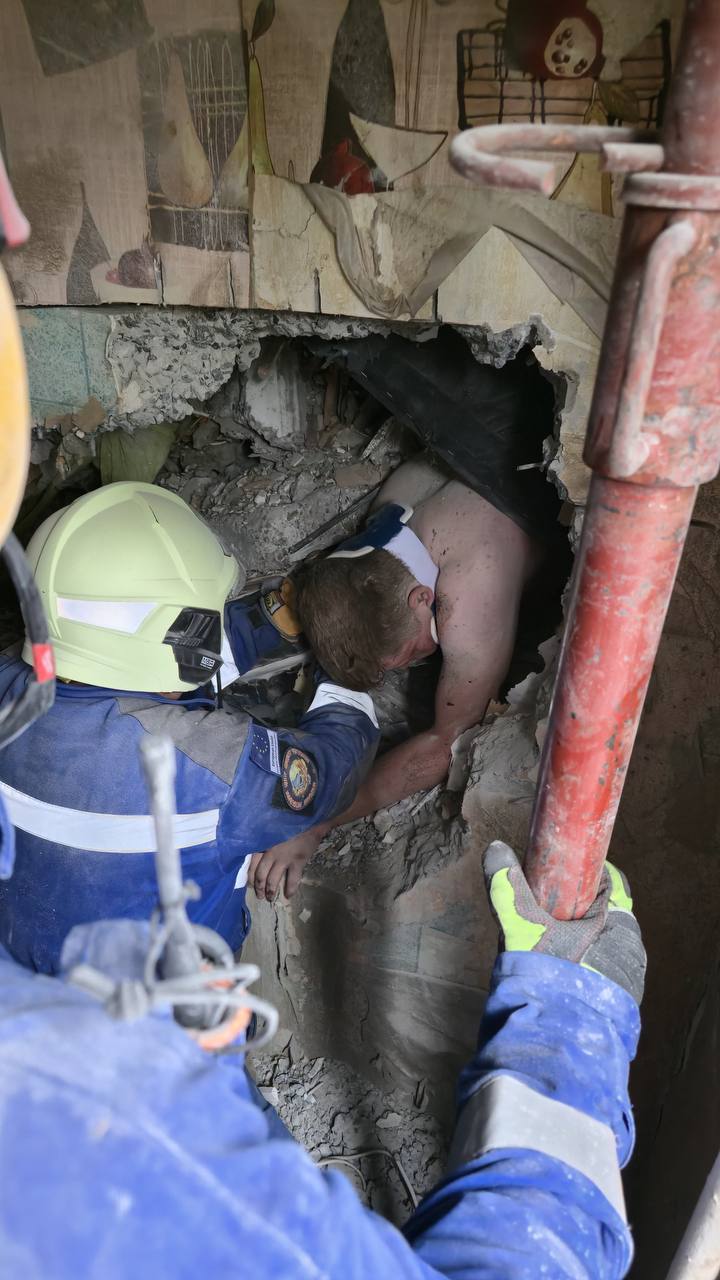
Among the injured are three police officers who were driving to a call. Nine children were among the injured.
“This is the largest number of injured children in one night in Kyiv since the start of the full-scale war,” Klitchko says
Klymenko told Suspilne that doctors tried to save the six-year-old boy but could not.
“The boy was rescued, doctors fought for his life, but sadly they could not save him.”
In Holosiivskyi district a missile damaged a school and a kindergarten and caused fires. In Shevchenkivskyi district the blast wave blew out windows in a children’s medical ward and burned parked cars.
Tkachenko and Klymenko warned that rescuers continue to search the rubble and that the number of victims will grow. The city opened assistance points for those who lost their homes and promised payments to cover temporary rent and support.
Air raid sirens began around 23:00 on 30 July and Suspilne reported explosions soon after. Another siren sounded at 04:29 on 31 July warning of missiles, followed by more explosions across the city. The Kyiv Military Administration said that missiles and drones were used in the attack.
The Prosecutor’s Office opened a pre-trial investigation under article 438 of the Criminal Code of Ukraine, treating the strike as a war crime because of the civilian deaths.
Ukraine’s Air Force said that from 18:00 on 30 July until the morning of 31 July Russians launched 317 aerial weapons: 309 Shahed one-way attack drones and decoy drones from Russian territory, and 8 Iskander-K cruise missiles. Air defenses destroyed or suppressed 291 targets: 288 drones and 3 missiles.
Despite this, five missiles, including one that hit an apartment building in Kyiv, and 21 drones struck 12 locations, while debris from intercepted targets fell in 19 places, almost all in the Ukrainian capital. The main target of the assault was Kyiv.


© Doug Mills/The New York Times


© Saher Alghorra for The New York Times


Russian forces launched a large-scale drone attack against Ukraine during the night of 30 July, causing civilian casualties and infrastructure damage across multiple regions. The assault injured at least five people and sparked fires at several enterprises.
The Ukrainian Air Force reported that Russia deployed 78 unmanned aerial vehicles of various types, including strike drones of the Iranian-designed Shahed type and decoy drones.
Ukrainian air defense systems successfully neutralized 51 of the attacking drones, with 27 recorded as hitting targets across seven locations and debris from destroyed drones falling in two additional areas.
The northeastern city of Kharkiv sustained significant damage when Russian drones struck the Shevchenkivskyi and Slobidskyi districts at approximately 1:55 a.m. Three people were injured in the attacks, according to Kharkiv Mayor Ihor Terekhov.
Russia terrorizes civilians in Ukraine every day.
— Euromaidan Press (@EuromaidanPress) July 30, 2025
On the night of 30 July, Russian drones attacked the eastern city of Kharkiv, injuring three residents and igniting fires across two city districts.
The strikes damaged a car wash, apartment building windows, and a supermarket… pic.twitter.com/S38iYIsq71
In the Shevchenkivskyi district, drone strikes damaged a car wash, shattered windows in apartment buildings, and hit a supermarket, while several vehicles caught fire. The Kharkiv Regional Prosecutor’s Office confirmed that drone debris injured a 24-year-old woman, a 33-year-old man, and a 62-year-old woman.
Russian forces used “Geran-2” type drones for the city attack. A second strike hit the Slobidskyi district around 2:40 a.m., damaging a non-residential building. Local prosecutors have opened war crimes investigations into both incidents.
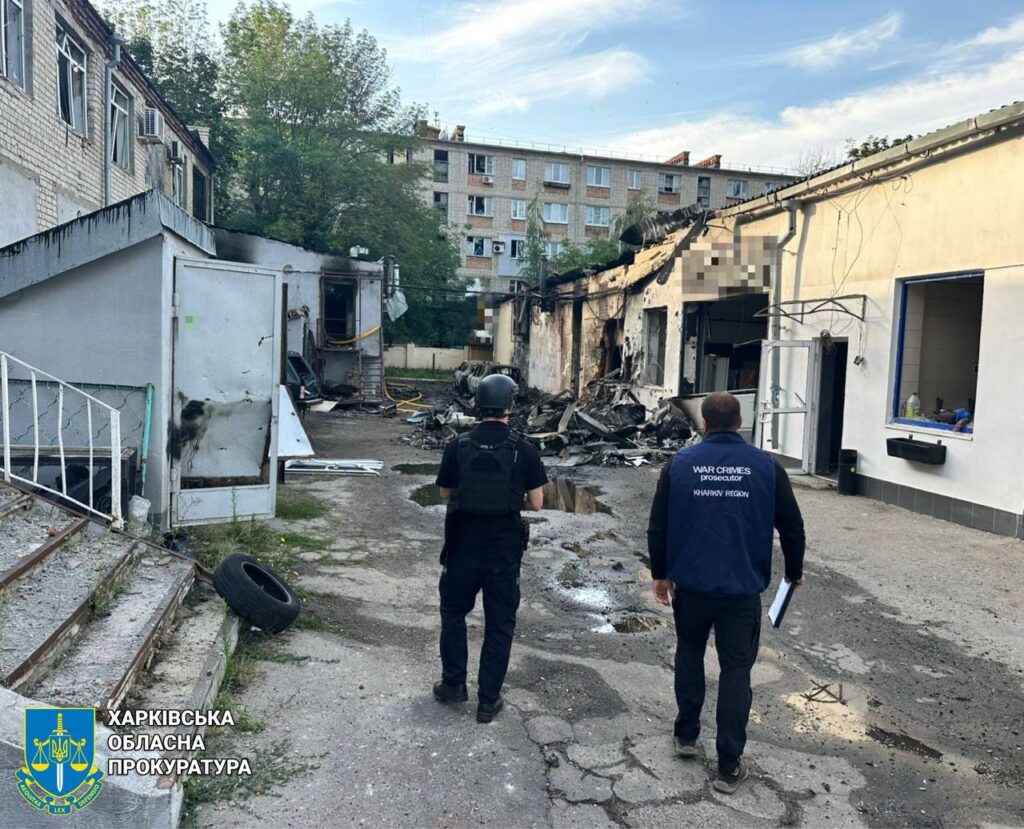
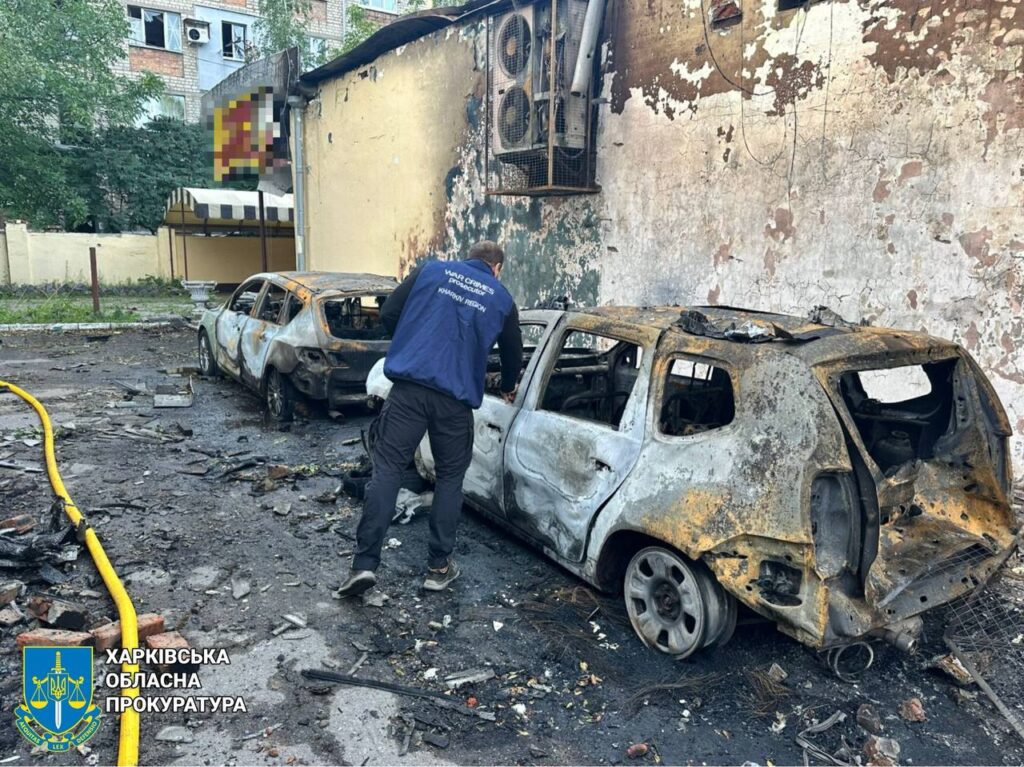
Russian attacks on Dnipropetrovsk region resulted in two civilian injuries and significant agricultural losses, according to regional military administration head Serhii Lysak. Ukrainian forces intercepted 24 drones targeting the region, but several strikes reached their intended targets.
In Pavlohrad, a 70-year-old man sustained injuries and required hospitalization after attacks damaged a transport enterprise and triggered multiple fires.
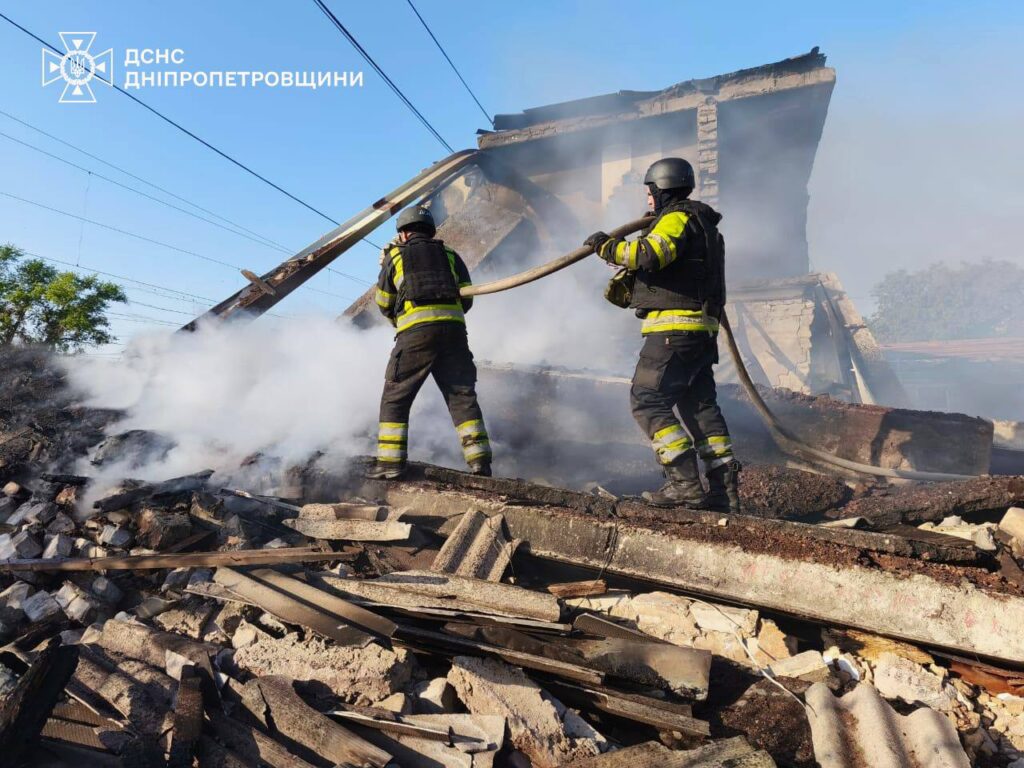

The assault also struck the local railway station, disrupting tracks and contact networks, though Ukraine’s national railway company Ukrzaliznytsia reported no casualties among passengers or staff.
Russian forces deployed FPV drones against three communities in the Synelnykivskyi district, destroying a farm and killing approximately 20 head of cattle, while damaging private enterprises.
In Mezhivska community, FPV drone attacks wounded one woman and destroyed five vehicles.
The latest assault followed a devastating missile attack on 29 July that struck Kamianske in Dnipropetrovsk Oblast.
That attack partially destroyed a three-story non-residential building and damaged nearby medical facilities, including a maternity hospital and city hospital department.
President Volodymyr Zelenskyy confirmed the death toll reached three people, including 23-year-old pregnant woman Diana, with the total number of casualties rising to 22.


© Reuters
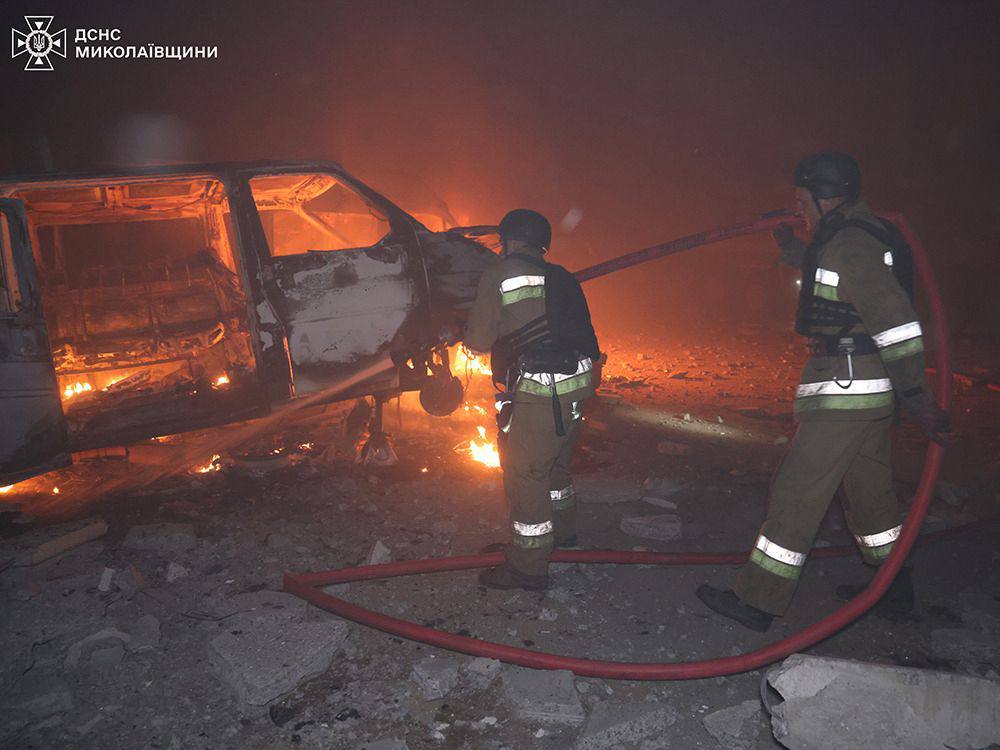

Pregnant woman among 22 killed by Russia in one day, Ukraine’s President Volodymyr Zelenskyy reported. Russian guided bombs, drones, and missiles targeted 73 Ukrainian towns and villages overnight, leaving homes, hospitals, and stores destroyed. The president said 85 more people were injured during the massive air assault.
Zelenskyy said a missile hit the premises of a hospital in Kamianske, Dnipropetrovsk Oblast, at two o’clock in the morning. Three people died in that attack. One of them was 23‑year‑old Diana, who was pregnant. The strike heavily damaged a maternity ward and the therapy unit’s building. Windows were shattered, cars burned, and nearby schools and kindergartens lost most of their glass and doors. 49 homes also suffered damage.
The head of Dnipropetrovsk Oblast, Serhii Lysak, said that Russia conducted a missile strike on Kamianske, while guided bombs and FPV drones struck communities in Synelnykove district.
“A three‑story building that was not in use was partially destroyed. Nearby, medical facilities were damaged: a maternity ward and a department of the city hospital,” Lysak wrote.
Lysak also reported that Russia used a KAB guided bomb against Velykomykhailivska community, killing a 75‑year‑old woman died and injuring a 68‑year‑old man. The attack damaged four houses, a gas station, stores and administrative buildings, and a truck caught fire. While firefighters were putting out the flames, Russian drones returned to strike them again, destroying a fire truck. None of the crew were injured, the Emergency Service says.
Nikopol, Marhanets and Pokrovska communities in the oblast also came under artillery and drone fire. Detached homes, farm buildings, a shop, a recreation facility, a power line and a vehicle were damaged.
Late in the evening and almost at midnight, Russian aircraft attacked a penal colony in Zaporizhzhia Oblast. Zelenskyy said the strike was deliberate and aimed at civilians inside the facility. The Russian attack killed 17 inmates, and wounded 42 more. 41 more people “sustained injuries of varying severity,” according to Ukraine’s Justice Ministry.
Ukraine’s Air Force said that starting from 21:40 on 28 July and through the night of 29 July, Russia launched two Iskander‑M ballistic missiles and 37 Shahed drones, along with decoy drones, from Russia and occupied Crimea. The attack came from the directions of Oryol, Kursk and Hvardiiske.
Air defense forces, including aviation, anti‑aircraft missile units, electronic warfare teams and mobile fire groups, shot down or suppressed 32 of the drones.
In his morning message, Zelenskyy praised US President Donald Trump for stating that Russia wastes the world’s time talking about peace while killing civilians. He said the Kremlin must be forced to end the war through strong sanctions and that true peace will come only when Russia stops its aggression.
“Russia killed 22 people in one day,” Zelenskyy said. “We all want real peace. Peace is possible when Russia ends the war it started.”
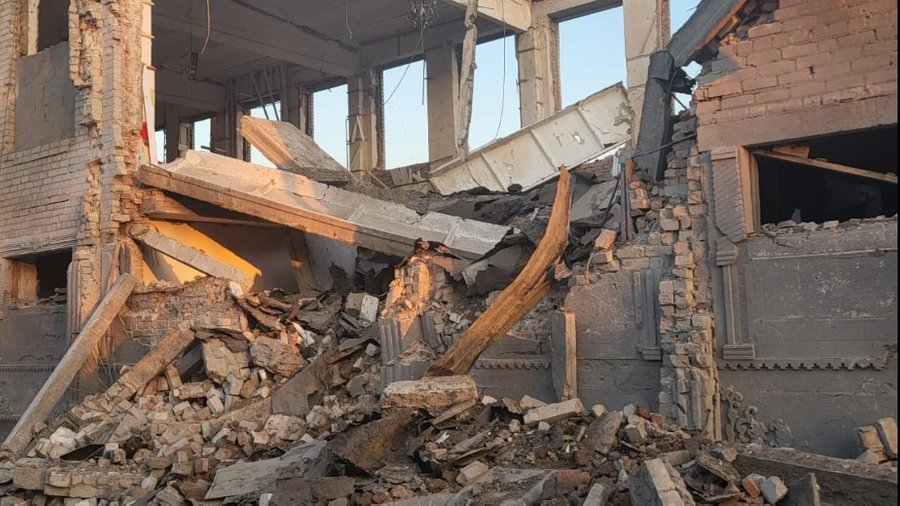

Russian bombing of a Ukrainian prison killed 17 people overnight, leaving dozens more injured, as eight strikes hit Zaporizhzhia district. Local officials said the attack also damaged single-family homes close to the prison.
Head of the Zaporizhzhia Oblast Administration Ivan Fedorov reported that Russian bombs struck a detention facility in the early hours of 29 July. He initially stated that 16 people died and 35 were injured. Medical teams continue to assist all the wounded.
Fedorov explained that Russian forces hit the Zaporizhzhia district eight times, using FAB heavy aerial bombs. The attack destroyed buildings of the facility, and also damaged the nearby detached homes.

According to updated information, the Russian army carried out an airstrike on the Bilenke Penal Colony No. 99, destroying the facility’s cafeteria, quarantine unit and administrative building.
“As a result of the strike, 17 inmates were killed and 42 others were wounded. Those with severe injuries were taken to hospitals run by the Health Ministry. Around 40 more people sustained injuries of varying severity, and one staff member of the facility suffered minor wounds from shrapnel to the face,” Ukraine’s Ministry of Justice reported.


© Saher Alghorra for The New York Times


© Amit Elkayam for The New York Times
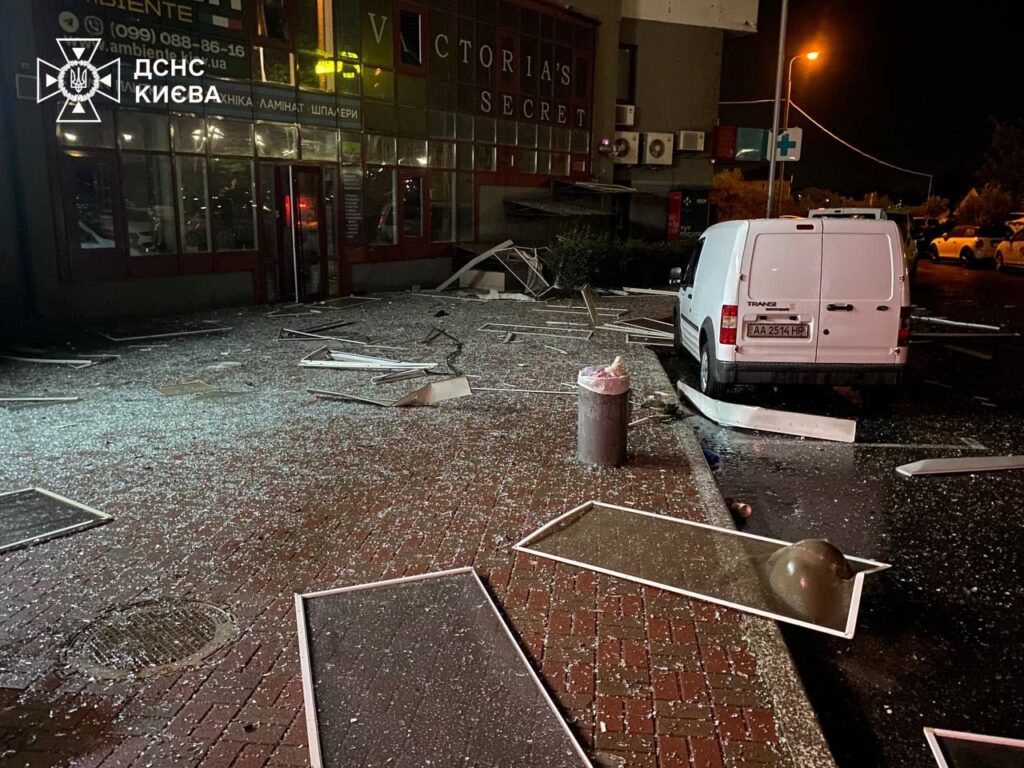

Russian forces conducted a large-scale aerial assault on Ukraine during the night of 28 July, targeting multiple regions across the country, with Kyiv, Kropyvnytskyi, Khmelnytskyi and Dnipropetrovsk oblasts sustaining the most damage and casualties.
According to regional authorities, at least 10 people were injured in the attacks, including three children aged 2, 3, and 15 years old.
On 27 and 28 July, Russia launched 331 aerial weapons, comprising 324 strike drones of Shahed type and decoy drones, 4 Kh-101 cruise missiles, and 3 Kh-47 M2 “Kinzhal” aeroballistic missiles, the Air Force reported.
Ukrainian air defenses successfully intercepted 311 of the attacking weapons by 09:30, including 309 strike drones and 2 cruise missiles. The primary target direction was Starokostiantyniv in Khmelnytskyi Oblast, according to the military.
Russia continues to target civilian areas. The third air raid alert in 12 hours followed a large-scale overnight attack.
— Euromaidan Press (@EuromaidanPress) July 28, 2025Starokostiantyniv, Khmelnytskyi Oblast was the main target. According to the Regional Military Administration, most missiles and drones were shot down, but… pic.twitter.com/V4Fz5dYrh9
In the capital, the Darnytskyi district bore the brunt of the attack when a residential 25-story building was struck.
According to Kyiv City Military Administration head Tymur Tkachenko, the blast wave shattered windows and damaged balcony glazing from the 3rd to 11th floors in one entrance, with additional window damage throughout the building.
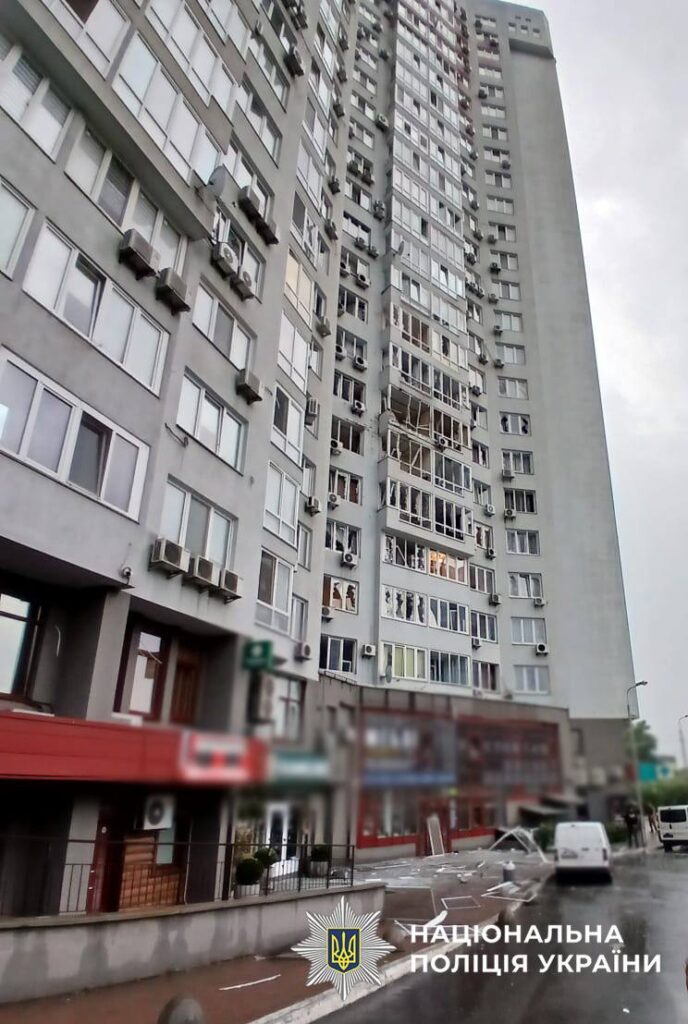
The National Police reported five people injured by shrapnel, including a 2-year-old girl who suffered lacerations to her foot. However, Tkachenko provided updated casualty figures, stating that eight people were injured overall, with four requiring hospitalization, one in serious condition. Among the hospitalized was a 3-year-old child with shrapnel wounds.
“The Russians cynically once again launch enemy strike UAVs at civilian objects, at our people,” Tkachenko wrote.
The courtyard and several cars parked near the building were also damaged, according to both the National Police and city administration.
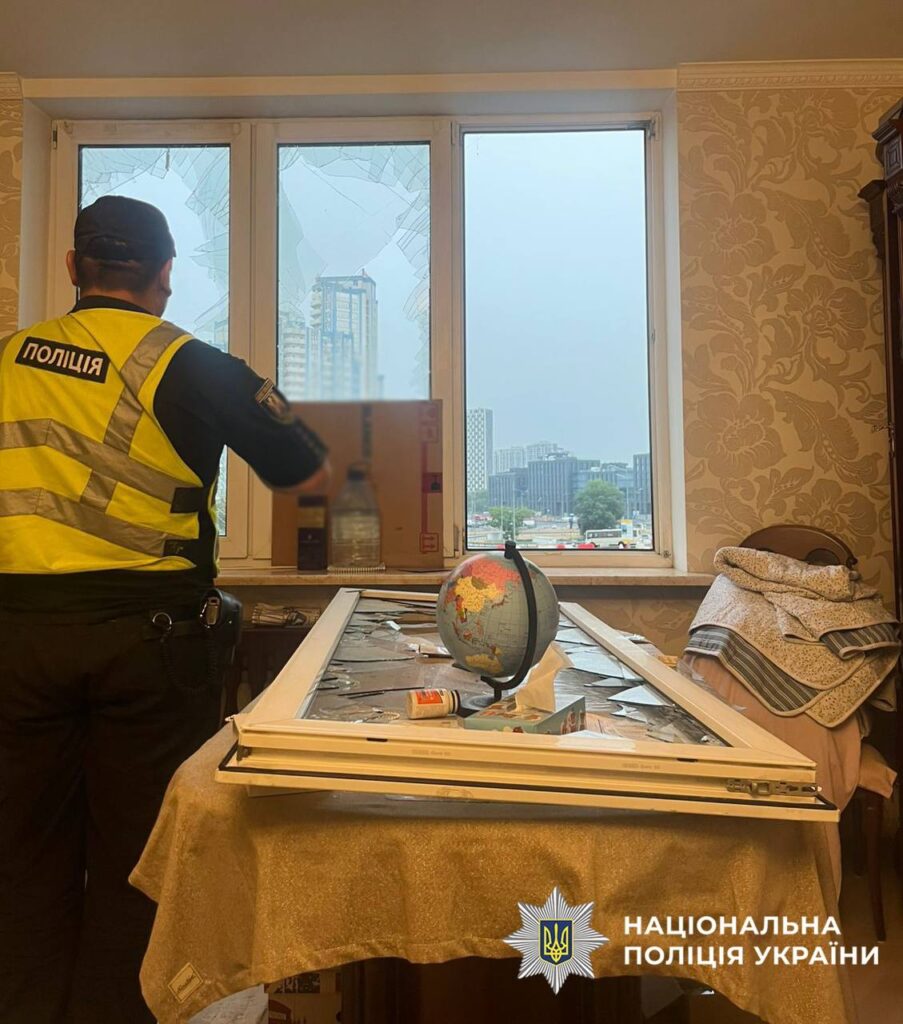
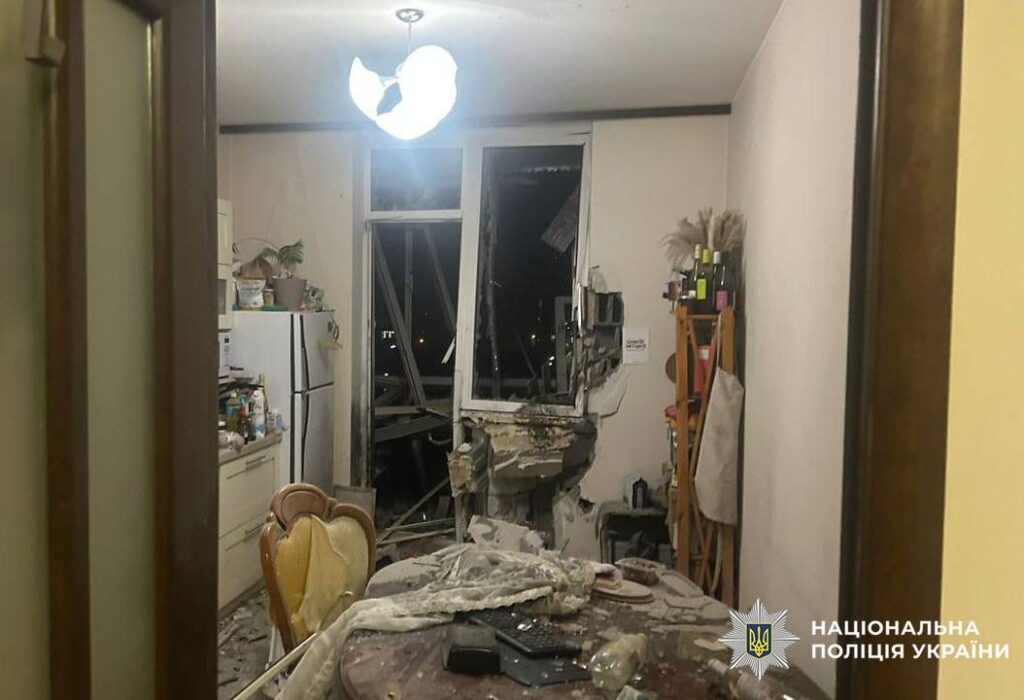
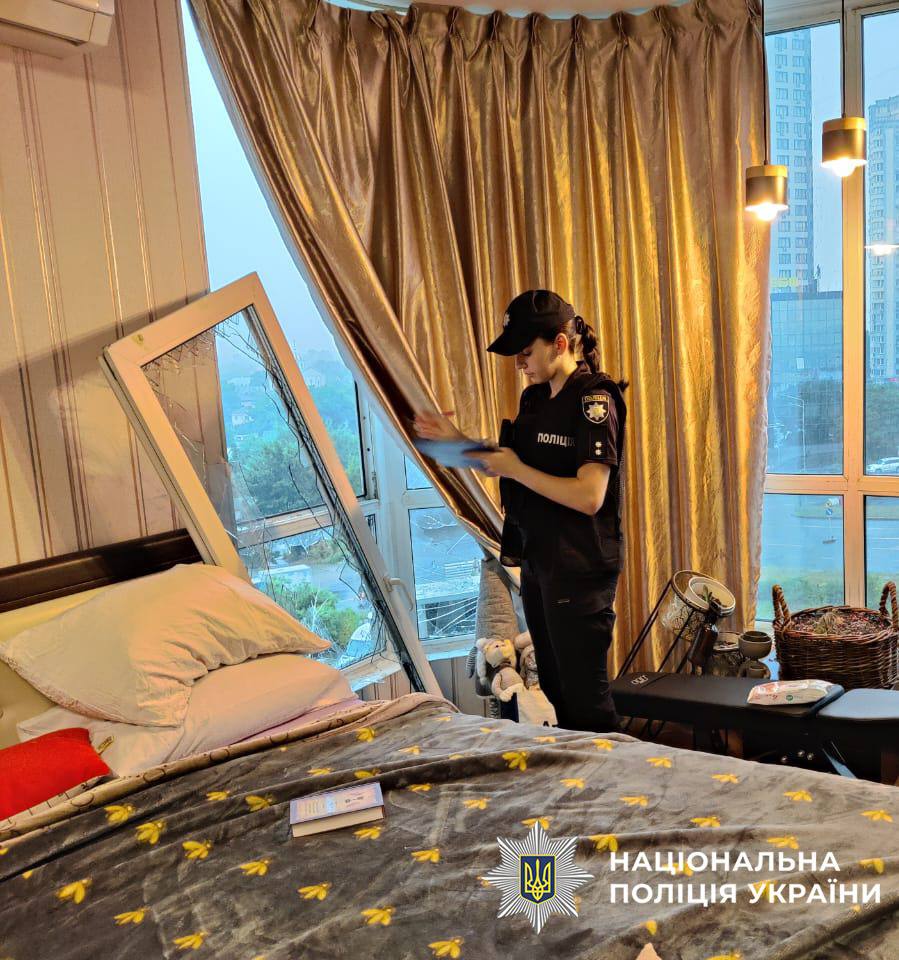
The city of Kropyvnytskyi in central Ukraine experienced a drone attack that resulted in a fire, according to local authorities. No casualties were reported, but the blast wave damaged the premises of the regional philharmonic hall. Emergency services continued firefighting operations as of the morning report.
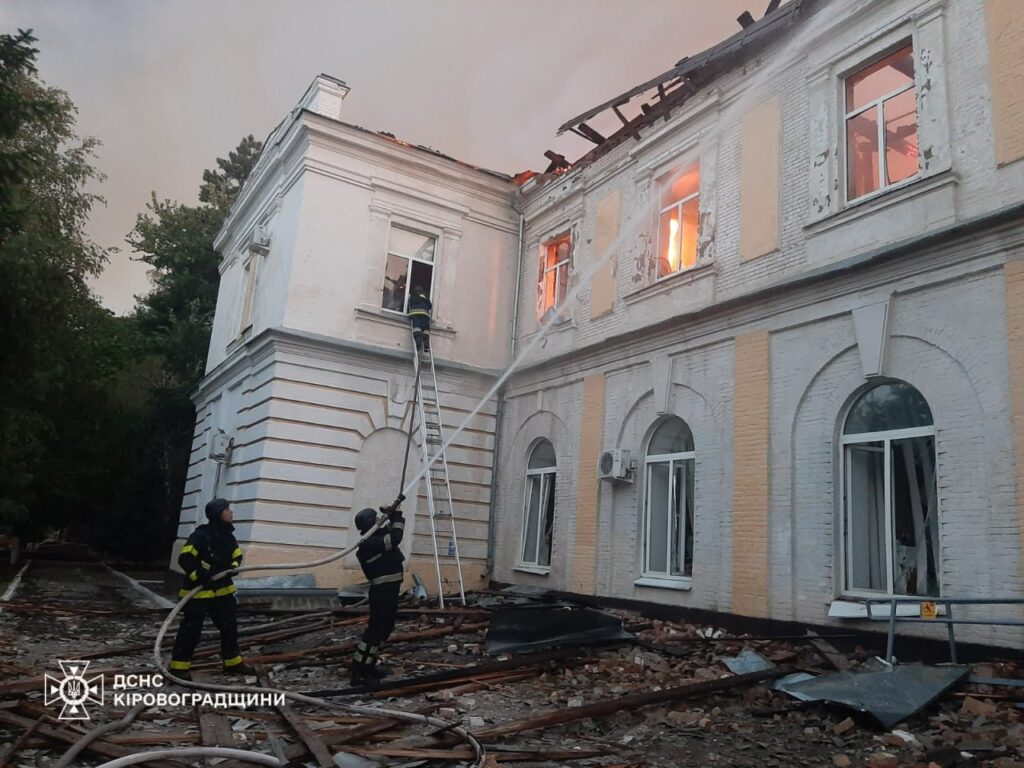

Two people were injured in drone and artillery attacks on the Nikopol district, according to Regional Administration Head Serhii Lysak. The casualties included a 15-year-old girl and a 49-year-old woman, both receiving outpatient treatment.
Lysak reported that Russian forces attacked the area with drones and artillery, affecting the district center and several communities including Marhanets, Myriv, Chervonohryhorivka, and Pokrovsk.
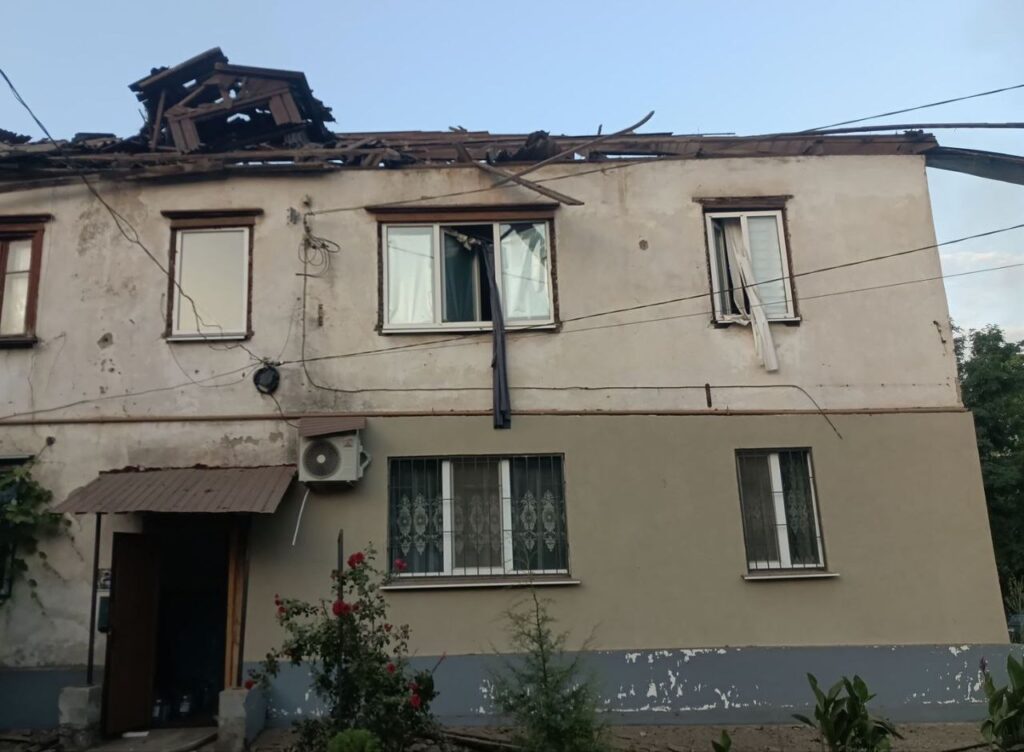
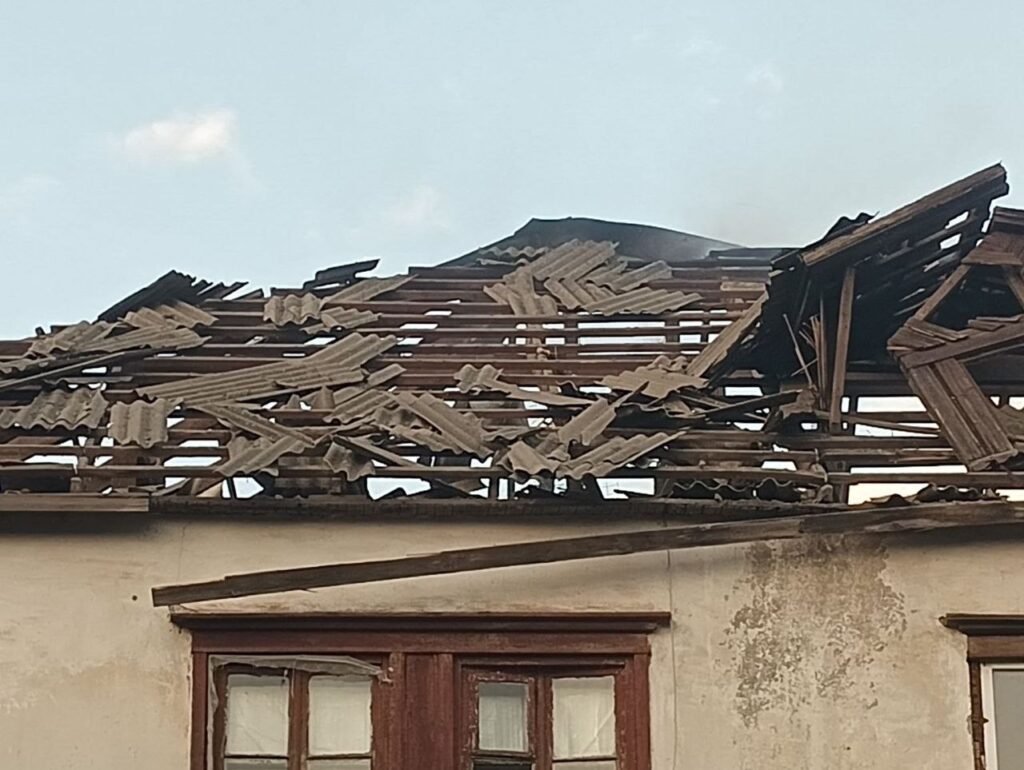
The attacks damaged an educational institution, one apartment building, three private houses, three utility buildings, and power lines, while also causing fires.


© Olivier Okande/Associated Press
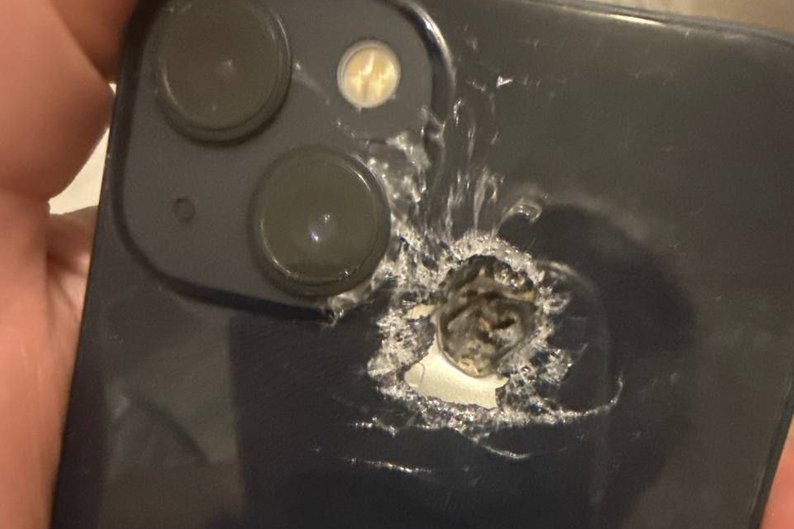

Ukraine endured another night of Russian drone attacks that left destruction in several oblasts. Civilian buildings, warehouses and public infrastructure were hit as waves of Shahed drones struck Kharkiv, Sumy, and Poltava.
In Kharkiv, residents spent another night under fire as explosions shook the city. Authorities confirmed that Russian forces attacked with ten Shahed-type drones. These drones struck the Kyivskyi district, where one hit a civilian enterprise that has not operated for years. Other strikes caused fires in a detached house in Kyivskyi district and in another building near the city. Mayor Ihor Terekhov later clarified that one of the attacks landed in a suburb rather than in Shevchenkivskyi district.
Emergency services reported that fires caused by the strikes were extinguished during the night. In Malodanilivska community, debris from drones set a 500 square meter production and storage building on fire. There were no injuries in Kharkiv during this latest wave.
In Sumy, Russian forces attacked several times on 26 July. The assault damaged the building of the Oblast Administration, a detached house across from it and a café. One of the strikes knocked out power to a local water supply facility. Later that evening, drones targeted the city again, striking the Kovpakivskyi district and wounding three civilians. According to Sumy Oblast head Oleg Hryhorov, all injured were hospitalized. Local police said a wounded 43‑year‑old man was in moderate condition.
On 27 July, Sumy came under another drone attack. This time, windows in homes and non-residential buildings were shattered, but there were no reported casualties.
Poltava oblast also faced damage from falling drone wreckage overnight on 27 July. Acting head of the Oblast Military Administration Volodymyr Kohut reported that debris from intercepted drones fell in Poltava and Kremenchuk districts. Four single-family homes and three farm buildings were damaged, but no one was injured.
Ukraine’s Air Force reported that Russia launched 83 drones, including Shahed and decoy types, from Russian territory and occupied Crimea starting at 22:30 on 26 July.
Air defenders used aviation, surface-to-air missile units, electronic warfare systems and mobile fire teams to repel the attack. By 10:30 on 27 July, air defenses had destroyed or suppressed 78 of the drones.


© Bilal Shbair for The New York Times


© Saher Alghorra for The New York Times
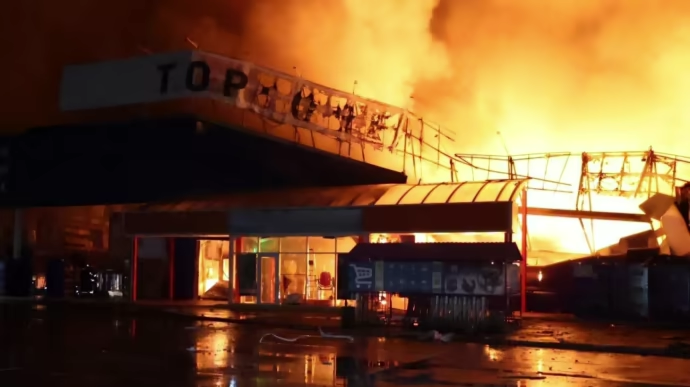

Ukraine’s response to recent Russian attacks on civilian cities will be swift. On 26 July, President Volodymyr Zelenskyy said the enemy will inevitably feel the consequences of their actions.
On the night of 26 July, Russian forces launched drones and missiles. Dnipropetrovsk, Kharkiv, and Sumy oblasts came under fire. Three people were killed in Dnipro, and six more were injured. Kharkiv endured three hours of relentless assault. The Russians used missiles, including ballistic ones, as well as attack drones.
The Ukrainian president stated that Russia will face retaliation for the killings.
Russia does not intend to end its war against Ukraine. On the contrary, Russian ruler Vladimir Putin has told US President Donald Trump that military actions will escalate during the summer offensive. In the first half of 2025, Russia killed or injured 6,754 civilians in Ukraine, the highest number for a six-month period since 2022.
“There are wounded as a result of the Russian strike. Unfortunately, there are also casualties. My condolences,” he wrote on Telegram.
He also emphasized: the response will be precise and daily.
“Russian military enterprises, Russian logistics, and Russian airports must feel that their own war has real consequences for them. The accuracy of our drones and the daily nature of Ukraine’s responses are among the arguments that will definitely bring peace closer,” Zelenskyy said.
Russia’s Defense Ministry justified the attack by claiming it targeted Ukrainian defense enterprises. In reality, the missiles hit residential buildings and an electronics repair store.
“The objective of the strike was achieved,” it reported.
Earlier, the Ukrainian Defense Intelligence said that a Su-27UB combat training jet caught fire overnight on 26 July in Russia. The incident happened at the Armavir airfield in Russia’s Krasnodar Krai, which lies more than 850 km from the Ukrainian border.
Ukraine’s Intelligence: Russian jet used to train war pilots suddenly bursts into flames in Krasnodar Krai
It is intended for training pilots for the war against Ukraine, while retaining the combat capabilities of the base aircraft: speeds of up to 2,500 km/h.


Russian forces launched a massive attack on Dnipro, Sumy, and Kharkiv oblasts, injuring 14 people and killing two others, according to regional authorities.
The Russian military regularly attacks Ukrainian oblasts with various types of weapons. Russia’s leadership denies that the Russian army has been conducting targeted attacks on the civilian infrastructure of Ukrainian cities and villages, killing civilians and destroying hospitals, schools, kindergartens, energy and water supply facilities.
On the night of 26 July, the Russian forces attacked with 235 air assets (208 UAVs and 27 missiles of various types). Ukraine’s Air defence shot down 200 Russian air targtes (183 attack UAVs and 17 missiles of various types)
Russian occupying forces launched a massive combined attack on Dnipro and the oblast overnight on 26 July, killing three people and injuring six others, Dnipro Oblast Governor Serhiy Lysak said.
Air defense forces shot down seven missiles and 26 drones, according to Lysak.
The attack claimed the life of a man in Dnipro, while a woman was injured. A multi-story building sustained damage, and industrial enterprises were hit. Fires broke out across multiple locations, including a parking lot where vehicles caught fire.
The Dniprovskyi district experienced several fires, with flames engulfing a shopping center. Fires also erupted at an enterprise, and dry grass burned in various locations, according to the regional administration head.
One person died in Dniprovskyi district, while four others sustained injuries, Lysak said. Russian forces struck the Pokrovska community in Synelnykivskyi district with guided aerial bombs, causing a fire to break out.
Russian forces also hit the Pokrovska community in Nikopolskyi district with an FPV drone and attacked Marhanetska community. No casualties were reported.
Dnipropetrovsk Oblast, located several tens of kilometers west of the frontline, has been under repeated Russian attacks.
Russian forces also launched a massive attack on Kharkiv and the oblast, Governor Oleh Syniehubov said. The attack with two missiles, four CABs, and 15 UAVs injured six people, including three employees of the State Emergency Service and a medical worker.
The attack also damaged industrial premises, food warehouses, and a car. The total area of the fires is approximately 2,500 square meters.
The Russian army also attacked Zmiiv overnight, injuring three people, including a medical worker.
Kharkiv, Kupiansk, and Chuhuiv districts also suffered Russian attacks, which resulted in damage to private houses, outbuildings, cars, an outpatient clinic, and a gymnasium.
Russians also attacked Sumy Oblast overnight on 26 July. According to Governor Oleh Hryhorov, women aged 57 and 50 and a 55-year-old man were injured in the attack. The attack also damaged residential houses, a shop, and an internet club.
The Russian army also attacked Zaporizhzhia district. Several fires were recorded, a non-residential building was hit, Governor Fedorov said. There were no casualties reported.
Russia is wiping out Ukrainian cities daily. In the first half of 2025, 6,754 civilians in Ukraine were killed or injured, the highest number for a six-month period since 2022, Miroslav Jenča, UN Assistant Secretary-General for Europe, Central Asia, and the Americas, said.


© Tierney L. Cross/The New York Times


Despite escalating fighting and a humanitarian catastrophe, the UN has received only 34% of the planned $2.6 billion for aid to Ukraine in 2025, reveals UN Deputy Secretary-General for Humanitarian Affairs Joyce Msuya, UkrInform reports.
In the first half of 2025, Russia killed or injured 6,754 civilians in Ukraine, the highest number for a six-month period since 2022. After a surge in Russian attacks on civilians following each US peace effort, President Donald Trump gave Russia a 50-day ultimatum to strike a peace deal with Ukraine. However, the attack continue.
“Without immediate funding, even priority programs may be shut down,” she warned during a UN Security Council meeting.
The UN has already launched its 2025–2026 winter response plan, which targets the 1.7 million Ukrainians left in high-risk areas.
Since the last Security Council meeting on 20 June, the humanitarian situation has significantly worsened, Msuya said. In the first half of 2025, the number of civilian casualties increased by nearly 50% compared to last year.
Currently, 13 million Ukrainians need assistance, but due to a funding shortfall, only 3.6 million have received it.
Access to Russian-occupied regions remains extremely limited, Msuya emphasized. This makes it impossible to provide basic aid to millions of civilians.
Russia is transforming occupied Ukrainian regions into military bases. Moscow troops use Donetsk and Luhansk oblasts to build up combat units, establish fortified positions, and organize logistics hubs. Meanwhile, from occupied Crimea, Russian forces are launching missiles and drones at other Ukrainian cities.
She stressed that Ukrainians cannot depend on donor fatigue or delay, urging UN member states to act without hesitation.
Earlier, Euromaidan Press reported that Ukrainians suffer from dehydration and violence in Donetsk. The city’s residents under the Russian occupation face catastrophic water shortages, with no supply to homes for up to three days at a time.
Military expert Roman Svitan said that the Russians destroyed the Khanzhonkivske Reservoir in 2022. The pumps capable of moving millions of tons of water were completely demolished. This water sustained all of Donbas, all the way to Mariupol.


Russia is wiping out Ukrainian cities daily. In the first half of 2025, 6,754 civilians in Ukraine were killed or injured, the highest number for a six-month period since 2022, says Miroslav Jenča, UN Assistant Secretary-General for Europe, Central Asia, and the Americas, UkrInform reports.
After a surge in Russian attacks on civilians following each US peace effort, President Donald Trump gave Russia a 50-day ultimatum to strike a peace deal with Ukraine. He warned that failure to comply would trigger harsh economic sanctions, including tariffs of around 100% not only against Russia itself but also against countries purchasing its energy resources.
Daily shelling of Ukrainian towns and villages with missiles and drones has only intensified, he said during a UN Security Council meeting. June saw the highest monthly civilian casualty count in three years.
In July alone, Russia launched at least 5,183 long-range munitions at Ukraine, including a record 728 drones on 9 July. Kyiv and the port city of Odesa have been hit hardest in recent weeks.
Even Ukraine’s western regions, once considered relatively safe, are no longer spared from massive aerial attacks.
According to official UN data, at least 13,580 civilians have been killed since Russia’s full-scale invasion of Ukraine began, including 716 children. Another 34,115 people have been injured.
“There is no safe place in Ukraine today,” said Jenča.
He stressed that international law clearly prohibits attacks on civilians and that the UN strongly condemns all such assaults.


© Saher Alghorra for The New York Times


© Heng Sinith/Associated Press


© Reuters
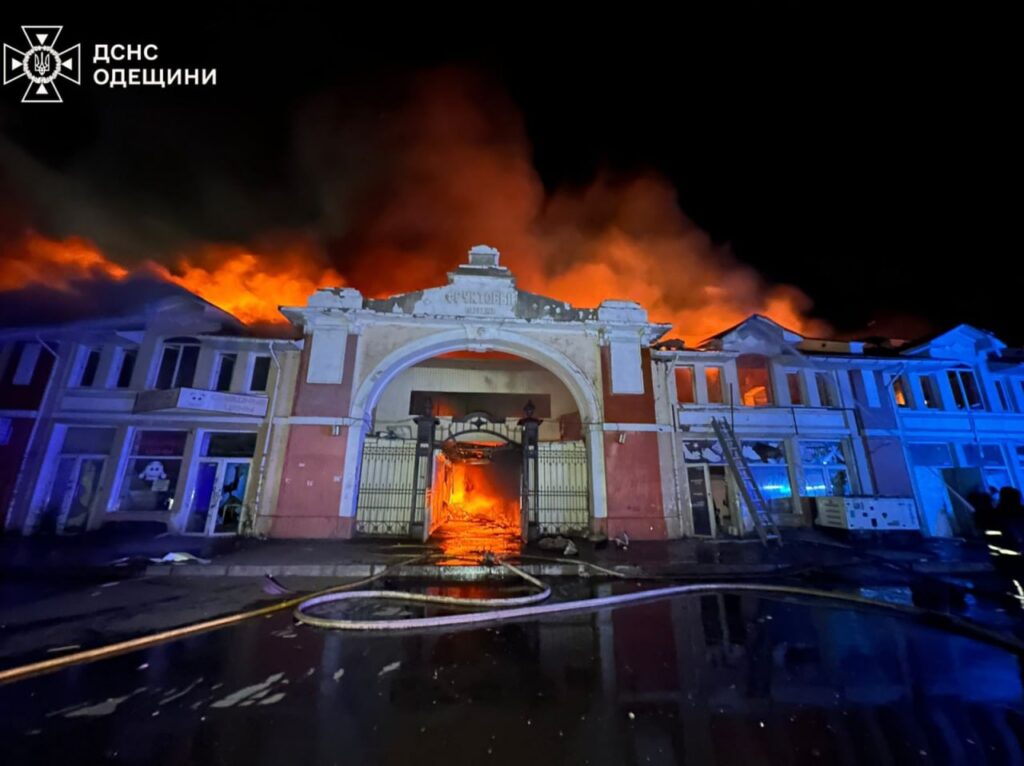

While Ukraine proposes peace, Russians again terrorize cities with missiles and drones. After talks in Istanbul where Ukraine offered a complete ceasefire, occupying Russian forces immediately struck Ukrainian cities, says President Volodymyr Zelenskyy.
“Yesterday at the meeting in Istanbul, the Russian side was again offered the proposal to immediately and fully cease fire. In response, Russian drones struck residential buildings and the ‘Pryvoz’ market in Oblast, apartment buildings in Cherkasy, energy infrastructure in Kharkiv region, a university gym in Zaporizhzhia, and targets in Donetsk, Sumy, and Mykolaiv regions,” Zelenskyy claims.
Pryvoz is one of the oldest and most famous markets in Odesa, a living iconic part of the city’s culture and history. Founded in 1827, it was the economic heart of the city, supplying food to Odesa and the region.

It became not only the main shopping place for locals but also a hub of Odesa’s humor. There, sellers and customers joke during bargaining, shout sayings, and win over buyers. It is believed that the unique Odesa dialect, the city’s distinctive linguistic culture, began forming there.
Volodymyr Zelenskyy emphasizes that Russia not only continues its terror but also blocks diplomatic efforts, thus deserving harsh sanctions and strikes on its logistics, military bases, and production facilities.
“We will do everything to make diplomacy work. But it is Russia that must stop this war it started,” the Ukrainian president stresses.
Earlier, German Foreign Minister Johann Wadephul said Kyiv forces would receive secret weapons to “influence” Russia’s territory. He did not mention specific names or dates for the deliveries.
As Putin vows summer escalation, Berlin says Kyiv will soon gain secret tools to “affect Russian territory”
Wadephul added that European partners worked intensively on delivering weapons to Ukraine. The issue is not about finances but about the defense industry’s production capacity.


© Abdulaziz Ketaz/Agence France-Presse — Getty Images


© Saher Alghorra for The New York Times


© Suy Se/Agence France-Presse — Getty Images


© David Guttenfelder/The New York Times
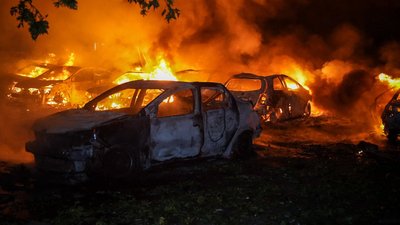

Russia’s latest attacks left at least three civilians dead and at least 25 injured across Ukraine, with strikes reported in Donetsk, Kherson, Sumy, Odesa, and Kharkiv oblasts. Russian drones targeted Odesa and Kharkiv, their bombs struck Kramatorsk and Sumy, while artillery shelling targeted Kherson and other cities.
Civilian casualties from Russian attacks mounted overnight on 22 July as a Russian guided bomb struck a residential building in Kramatorsk, Donetsk Oblast. According to the head of the city’s military administration, Oleksandr Honcharenko, the strike killed a 9-year-old boy born in 2015. Five more civilians were injured. The explosion caused a fire in the building, which was extinguished by emergency services.
The killed boy was among three civilians killed in Donetsk Oblast over the previous 24 hours, according to the oblast military administration. Russian forces killed one more person in Kostiantynivka with shelling and another in Zarichne. Meanwhile, they injured five civilians in Sloviansk and two more in Dobropillia. Russian attacks also wounded one person each in Rodynske, Lyman, and Shandryholove.
Kherson city and the village of Inzhenerne came under Russian artillery fire early in the morning on 22 July. The Russian attack injured a 62-year-old man while outside in Inzhenerne. Minutes later, at 08:10, Russian shelling hit Kherson, wounding a 54-year-old man. Another victim, a 55-year-old woman, was later reported injured from the same barrage. All three suffered explosive trauma and shrapnel wounds and were hospitalized, according to the Kherson Oblast Military Administration.
Authorities confirmed that seven people had been wounded across Kherson Oblast in the previous 24 hours due to artillery and drone attacks.
Odesa was once again targeted by Russian drones launched from the direction of occupied Crimea and the Black Sea.
In Odesa, a Russian drone injured one person. Debris from intercepted drones sparked a fire in a parking lot. Multiple vehicles were destroyed. The impact also shattered windows in a multi-story residential building and damaged a shop, local authorities reported. The State Emergency Service of Odesa Oblast reported that 62 rescuers and 17 vehicles were deployed to manage the aftermath. Three separate crash sites were confirmed in the city.

Suspilne reports that air raid sirens were activated at 01:48. Mayor Hennadii Trukhanov issued an early warning to residents of the Arcadia and Fontanka districts. Explosions followed shortly after.
Russian forces targeted seven settlements in Kharkiv Oblast over the past 24 hours using a mix of Shahed drones, FPV drones, and another unidentified UAV. The oblast military administration confirmed three civilian injuries.
The Russian strikes injured an 84-year-old woman Kupiansk, a 67-year-old woman in Ivano-Shyichyne, Bohodukhiv community. In the village of Verbivka, Balakliia community, a 29-year-old man was hurt after stepping on an unidentified explosive object.
In Sumy, Russia launched a strike on 21 July at approximately 22:30. According to the Sumy City Military Administration, three people were injured, including a child. Acting mayor Artem Kobzar said the Russians used two KAB-type guided bombs. The Sumy Oblast Military Administration added that the attack damaged five apartment buildings, a shopping center, and 18 vehicles. A 60-year-old woman and a 38-year-old man were hospitalized with confirmed injuries.
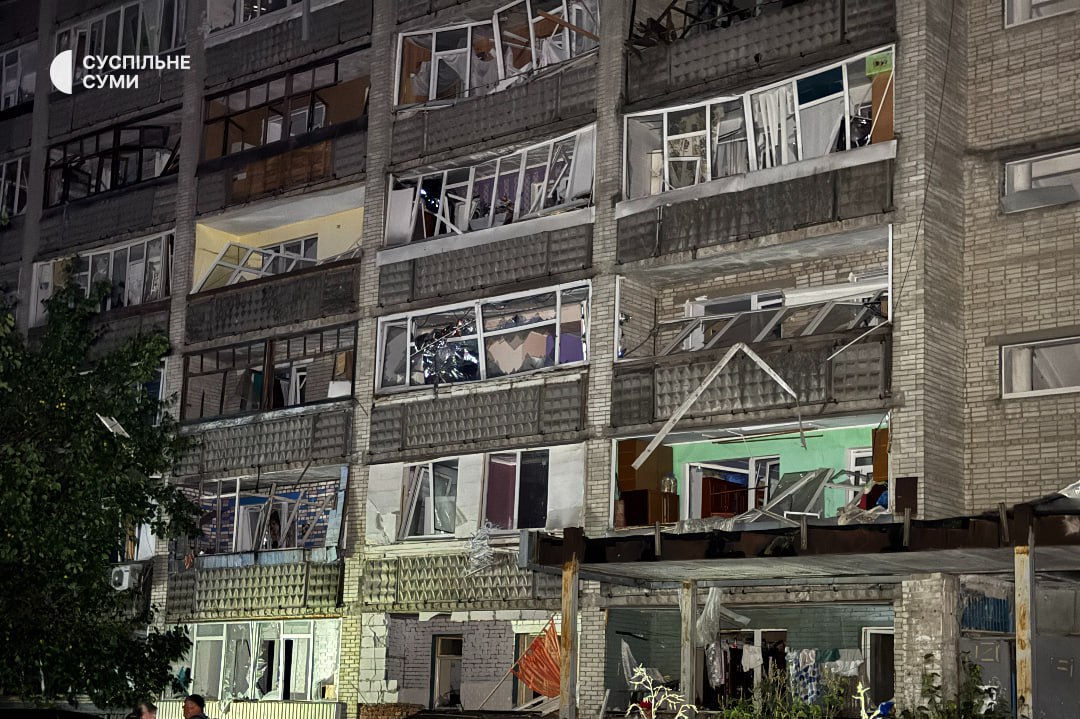
Serhii Kryvosheienko, head of the Sumy MVA, warned that more casualties were possible and that emergency teams were still working at the scene.


© Saher Alghorra for The New York Times
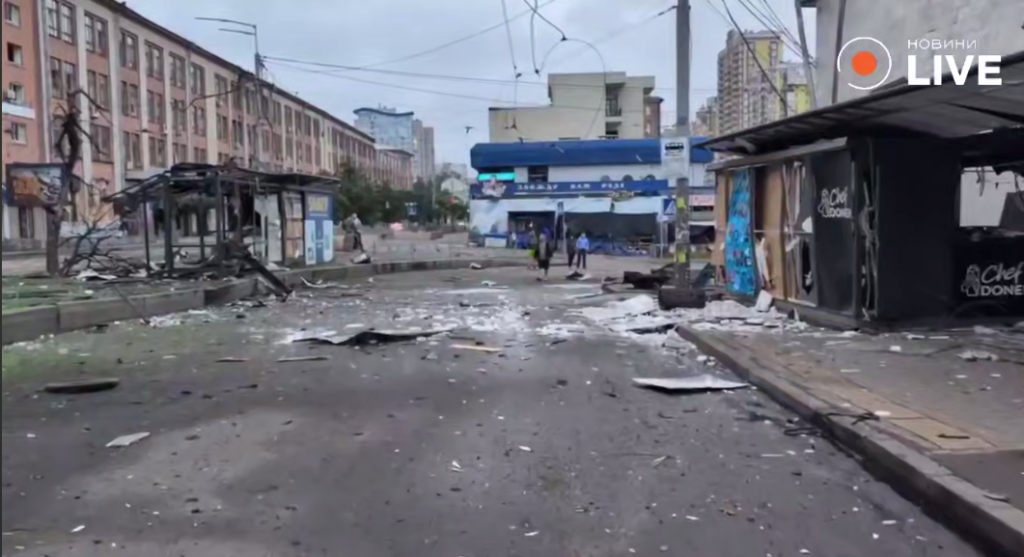

Ukrainian air defense forces shot down 224 targets during the Russian assault overnight into 21 July.
According to the Ukriane’s air defense forces, an additional 203 drones failed to reach their intended targets. The miitary confirmed 23 strike drones hit targets at 3 locations, with debris from destroyed drones falling at 12 locations.
The overnight assault represented another large-scale combined air attack by Russia on Ukraine, with occupying forces deploying strike drones and missiles of various types. Explosions were heard across multiple oblasts throughout the night. Among other oblasts, Kyiv and Ivano-Frankivsk faced the heaviest attack.
Four people, including one child, were injured in Ivano-Frankivsk Oblast during Russia’s overnight rocket and drone attack on 21 July, according to the State Emergency Service of Ukraine (DSNS). Residential buildings were damaged.
The attack on Ivano-Frankivsk was particularly severe. Mayor Ruslan Martsinkiv described the strikes as “the most large-scale” since the beginning of the full-scale invasion, stating there were “very many” hits on the city.
Beyond the residential casualties, fires erupted across multiple locations in the oblast. In the Gorodenkivka territorial community of Kolomyia district, a fire broke out in an agricultural building, which has been extinguished with no casualties reported. In Ivano-Frankivsk city center, emergency services extinguished fires at garages and vehicles in an open parking area covering 220 square meters, as well as industrial and warehouse facilities spanning 300 square meters.
Kyiv bore significant damage from the attack. One person died and six others were injured in the capital, including a 15-year-old girl, reports the National Police of Ukraine.
In Solomianskyi district, a man died. In Darnytskyi district, five people aged 36 to 55 years received shrapnel injuries. Among them is a 15-year-old girl. In Shevchenkivskyi district, an elderly woman was hospitalized.
The capital sustained widespread damage to residential buildings, a kindergarten, a supermarket, small architectural forms, garages, transport, warehouse facilities, and the ground section of a metro station. Destruction and debris were recorded in Holosiivskyi, Darnytskyi, Dniprovskyi, Obolonskyi, Sviatoshynskyi, Solomianskyi, and Shevchenkivskyi districts.
The blast wave also affected a police crew responding to an emergency call.
Metro station “Lukianivska” in Kyiv temporarily suspended passenger service due to damage to its ground section caused by the Russian shelling. Traffic was blocked on several streets in Darnytskyi and Shevchenkivskyi districts following the attack.


© Saher Alghorra for The New York Times


© Saher Alghorra for The New York Times
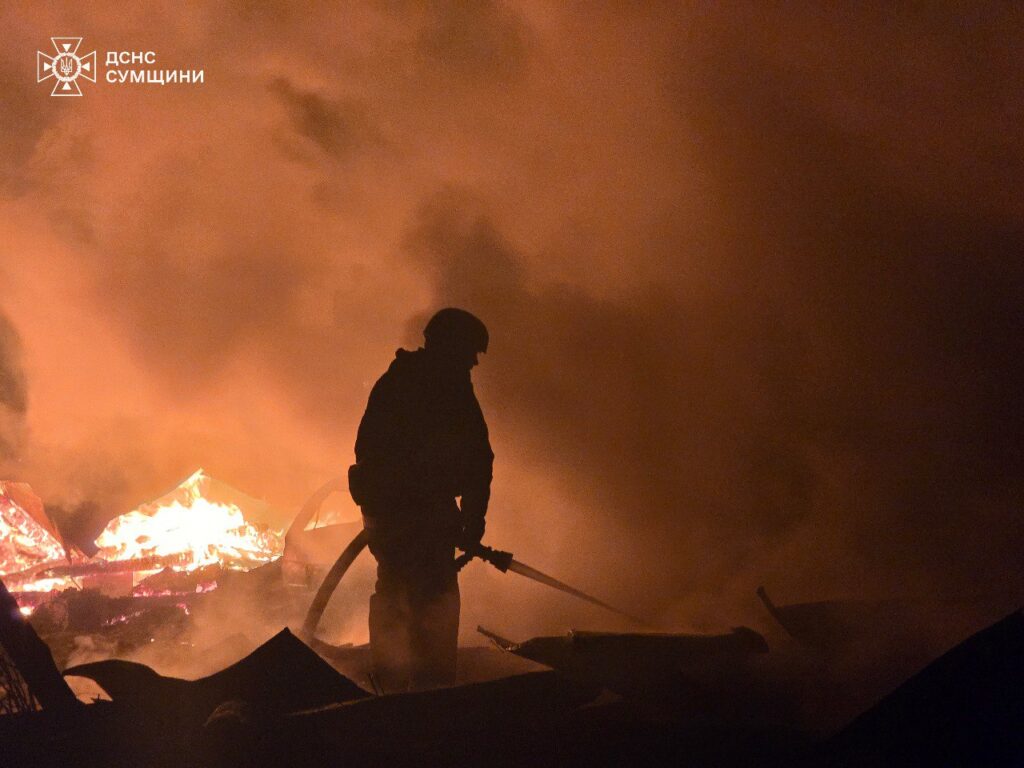

Russian forces conducted widespread drone attacks across multiple Ukrainian regions overnight on 20 July, killing at least one person and injuring several others while causing significant damage to residential areas.
The assault involved 57 Shahed strike drones and decoy aircraft, representing a relatively modest scale compared to Russia’s typical mass drone attacks, which often involve hundreds of aircraft and have reached over 700 drones in a single night.
According to the Air Forces of the Armed Forces of Ukraine, Ukrainian air defenses successfully intercepted 18 of the attacking drones, while electronic warfare systems suppressed or caused the loss of seven additional aircraft. The military reported that 32 drones struck targets across 10 locations, with debris from intercepted aircraft falling in six areas.
The deadliest impact occurred in northeastern Sumy Oblast near the front line, where a 78-year-old woman was killed during a Russian drone attack on residential areas in Svesa community, according to the State Emergency Service. Four strike drones targeted a village, causing three residential buildings to ignite immediately upon impact.
Russian terror campaign against Ukrainian civilians continues.
— Euromaidan Press (@EuromaidanPress) July 20, 2025
On the night of 20 July, Russian drones killed a 78-year-old woman and ignited three homes in a northeastern Sumy village near the front line.
Emergency responders faced dangerous delays because Russian forces… pic.twitter.com/LIeeAgSHJq
Rescue operations faced significant delays because Russian forces conducted follow-up strikes on the same locations where emergency workers needed to operate. Despite the dangerous circumstances and intense fire conditions, emergency personnel successfully extinguished all blazes and prevented the fire from reaching two nearby residential buildings.
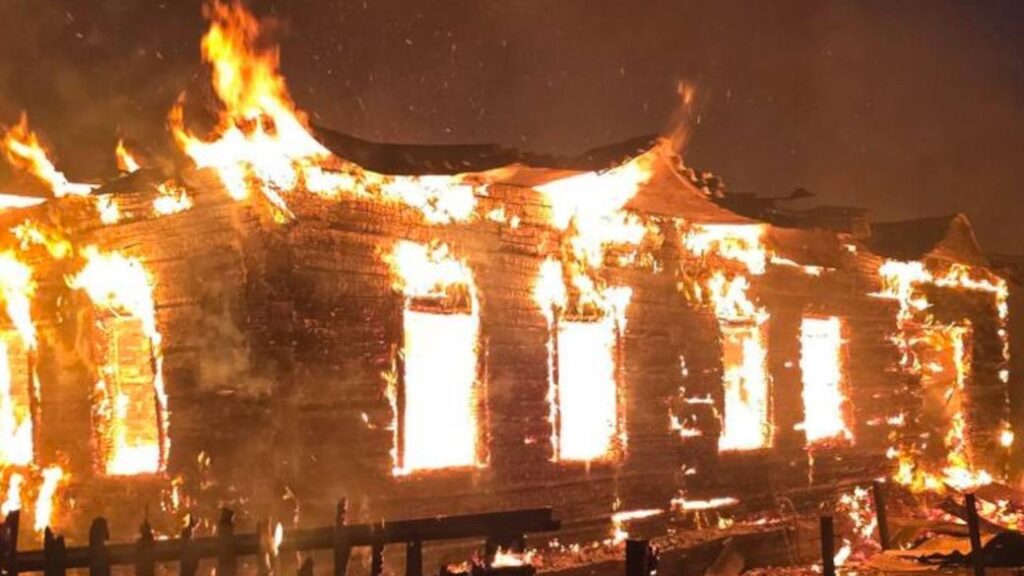
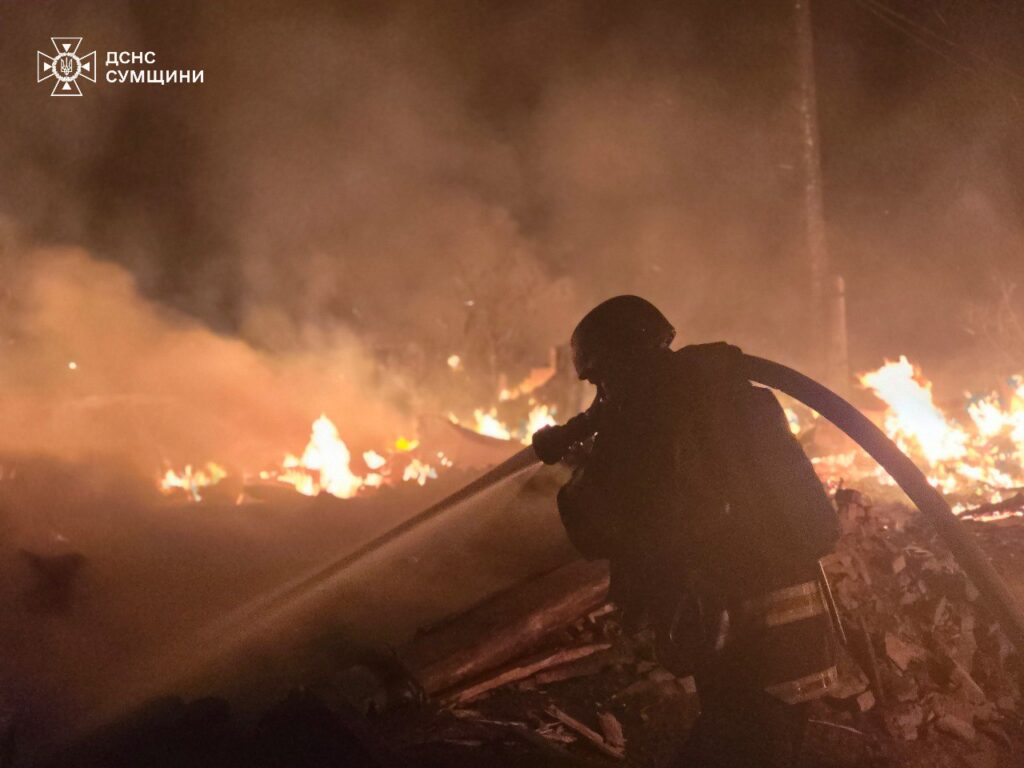
Southern Zaporizhzhia and surrounding areas faced intensive attacks involving at least 14 strike drones and two multiple rocket launcher system strikes, according to Regional Military Administration head Ivan Fedorov. The bombardment damaged seven private residences and caused window and facade damage to apartment buildings, while also sparking multiple fires. A 69-year-old woman sustained injuries in the attacks.
The nearby settlement of Prymorske also came under assault, where a Russian drone directly struck a residential building, injuring two elderly women aged 64 and 73.
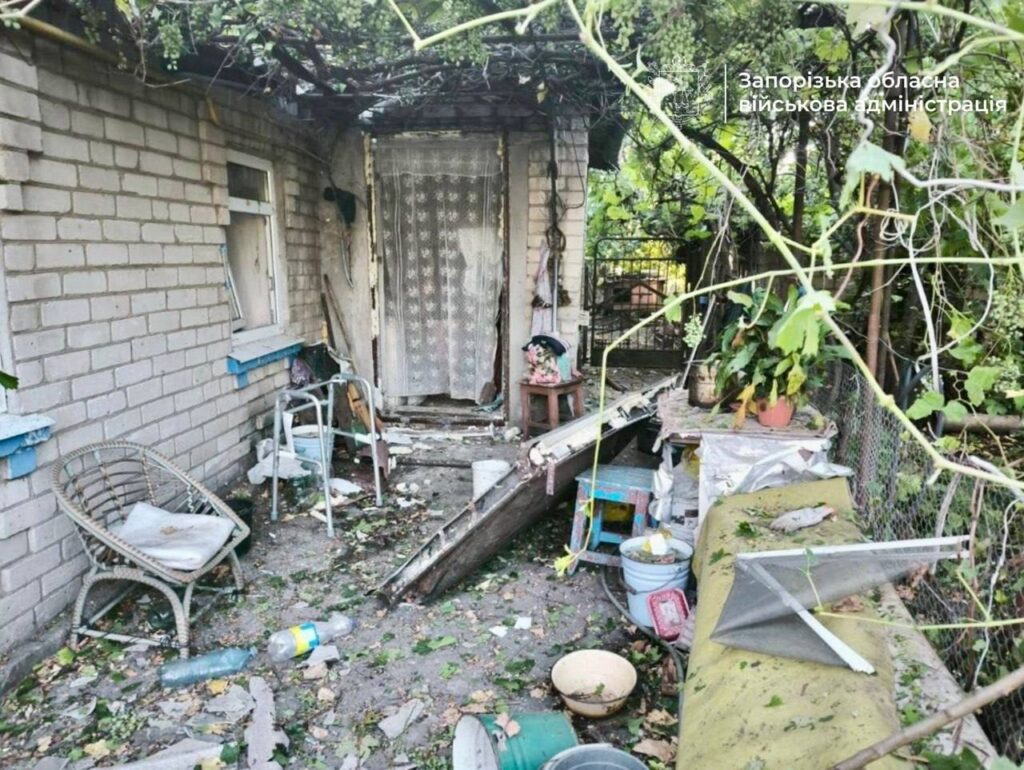
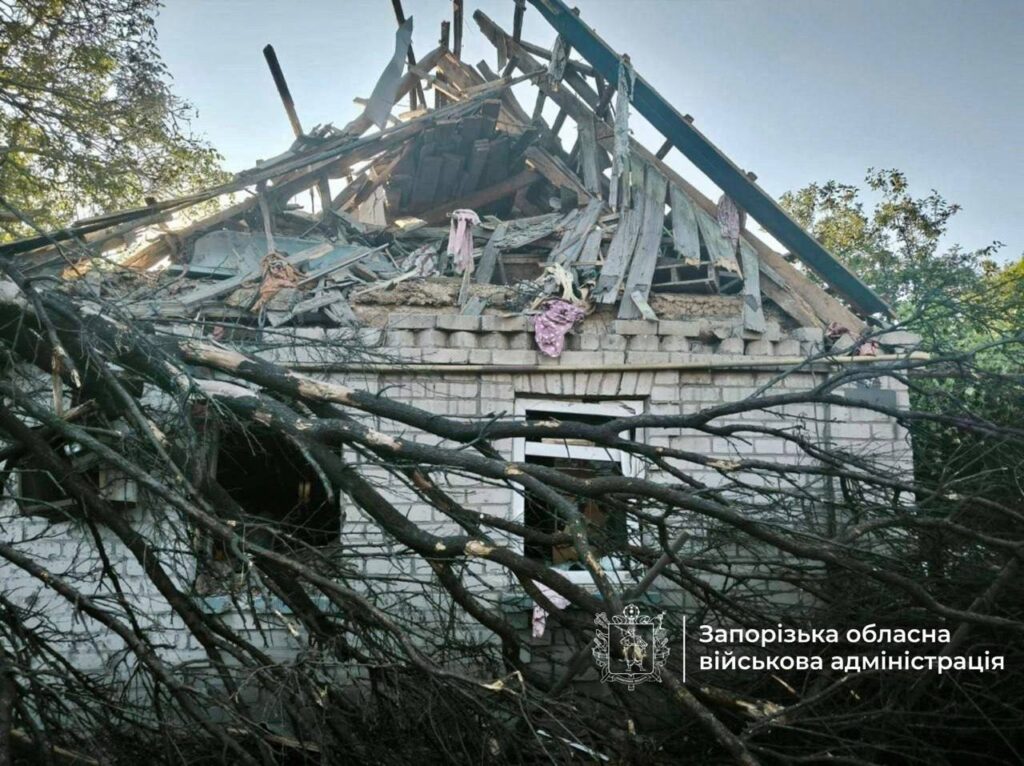
In southern Kherson Oblast, Russian forces targeted the settlement of Zymivnyk, resulting in injuries to a 17-year-old girl and her 51-year-old father, both of whom required hospitalization, according to Regional Military Administration head Oleksandr Prokudin.
“As a result of the enemy attack, the 17-year-old girl sustained explosive and traumatic brain injuries, concussion, and shrapnel wounds to the shin. The 51-year-old man sustained explosive trauma, thermal burns to the chest and poisoning from combustion products,” Prokudin reported. Both victims are receiving medical treatment at local hospitals.


© Mariam Dagga/Associated Press
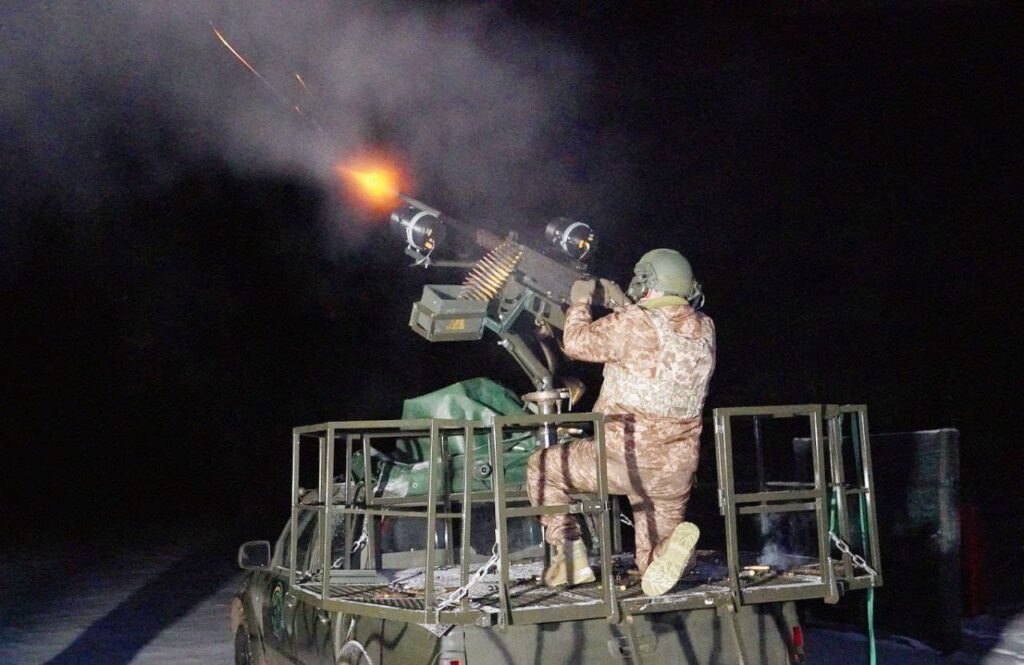

Last night’s Russian drone strike, including 35 one-way attack and decoy drones, killed a railway worker and injured several more civilians in three Ukrainian regions as the Shahed drones hit homes and infrastructure across three oblasts.
Ukraine’s Air Force reported that Moscow’s forces launched 35 unmanned aerial vehicles, including 29 Shaheds and multiple decoy drones, from the directions of Russia’s Millerovo and Primorsko-Akhtarsk. The attack began around 21:30 on 17 July and continued into the early hours of 18 July.
Air defense units reportedly destroyed 11 drones over Ukraine’s northern and eastern regions. Six decoy drones disappeared from radars or were suppressed by electronic warfare.
In Dnipropetrovsk Oblast, a Russian drone strike kills a railway worker and injures two others. The head of the oblast administration, Serhii Lysak, confirmed that drones hit communities in Pavlohrad and Synelnykove districts. A 52-year-old man was killed in the Verbkivska and Bohdanivska areas, and two men aged 38 and 40 were wounded. A fire broke out at a local transport facility, which was later extinguished.
Ukrzaliznytsia added that a drone also struck an electric locomotive. The train operator was killed, and his assistant was wounded but remains in stable condition.
Three Shahed drones were downed over the oblast by Ukrainian air defenses.
According to Lysak, a small FPV kamikaze drone also targeted Nikopol. The aftermath is still under investigation.
In Zaporizhzhia Oblast, Russian drones struck Andriivka village in the Zaporizhzhia district. According to oblast head Ivan Fedorov, nine Shahed drones hit the area, injuring a 79-year-old man. Fires erupted at non-residential buildings and several structures were destroyed.
In Kharkiv Oblast, Russian drones targeted the city of Chuhuiv. Mayor Halyna Minaieva reported that four civilians were wounded. The strike damaged residential buildings, a family doctor’s office, and an educational institution.


© Getty Images


© Omar Al-Qattaa/Agence France-Presse — Getty Images


© Ampe Pedro/The Halo Trust, via Reuters; Tim Graham Photo Library, via Getty Images